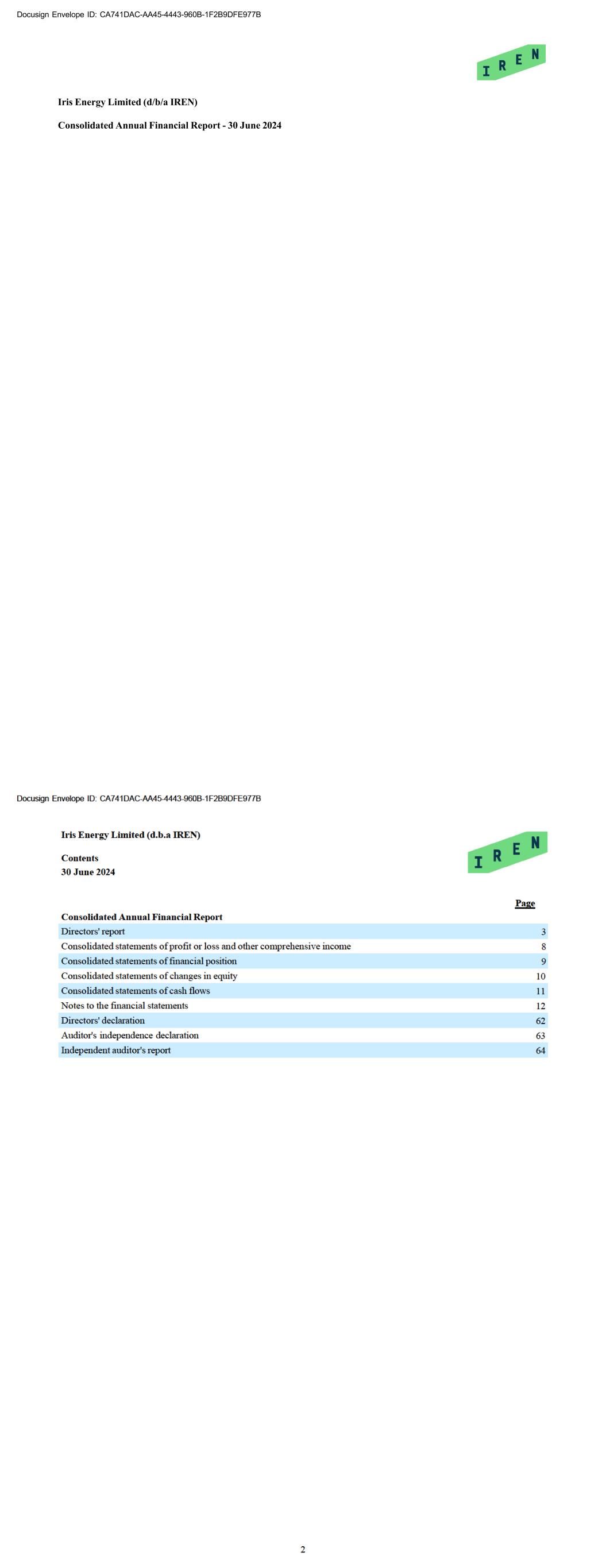
Docusign Envelope ID: CA741DAC-AA45-4443-960B-1F2B9DFE977B Iris Energy Limited (d/b/a IREN) Consolidated Annual Financial Report - 30 June 2024
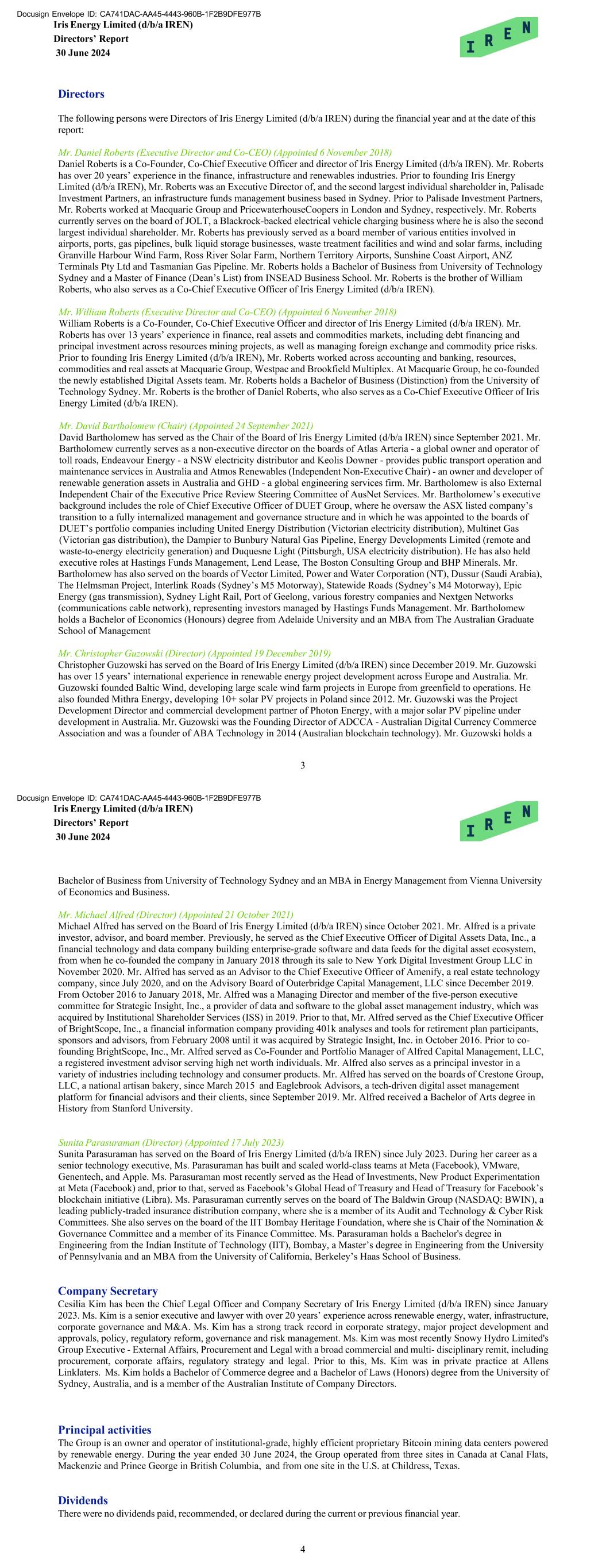
Docusign Envelope ID: CA741DAC-AA45-4443-960B-1F2B9DFE977B Iris Energy Limited (d/b/a IREN) Directors’ Report 30 June 2024 3 Directors The following persons were Directors of Iris Energy Limited (d/b/a IREN) during the financial year and at the date of this report: Mr. Daniel Roberts (Executive Director and Co-CEO) (Appointed 6 November 2018) Daniel Roberts is a Co-Founder, Co-Chief Executive Officer and director of Iris Energy Limited (d/b/a IREN). Mr. Roberts has over 20 years’ experience in the finance, infrastructure and renewables industries. Prior to founding Iris Energy Limited (d/b/a IREN), Mr. Roberts was an Executive Director of, and the second largest individual shareholder in, Palisade Investment Partners, an infrastructure funds management business based in Sydney. Prior to Palisade Investment Partners, Mr. Roberts worked at Macquarie Group and PricewaterhouseCoopers in London and Sydney, respectively. Mr. Roberts currently serves on the board of JOLT, a Blackrock-backed electrical vehicle charging business where he is also the second largest individual shareholder. Mr. Roberts has previously served as a board member of various entities involved in airports, ports, gas pipelines, bulk liquid storage businesses, waste treatment facilities and wind and solar farms, including Granville Harbour Wind Farm, Ross River Solar Farm, Northern Territory Airports, Sunshine Coast Airport, ANZ Terminals Pty Ltd and Tasmanian Gas Pipeline. Mr. Roberts holds a Bachelor of Business from University of Technology Sydney and a Master of Finance (Dean’s List) from INSEAD Business School. Mr. Roberts is the brother of William Roberts, who also serves as a Co-Chief Executive Officer of Iris Energy Limited (d/b/a IREN). Mr. William Roberts (Executive Director and Co-CEO) (Appointed 6 November 2018) William Roberts is a Co-Founder, Co-Chief Executive Officer and director of Iris Energy Limited (d/b/a IREN). Mr. Roberts has over 13 years’ experience in finance, real assets and commodities markets, including debt financing and principal investment across resources mining projects, as well as managing foreign exchange and commodity price risks. Prior to founding Iris Energy Limited (d/b/a IREN), Mr. Roberts worked across accounting and banking, resources, commodities and real assets at Macquarie Group, Westpac and Brookfield Multiplex. At Macquarie Group, he co-founded the newly established Digital Assets team. Mr. Roberts holds a Bachelor of Business (Distinction) from the University of Technology Sydney. Mr. Roberts is the brother of Daniel Roberts, who also serves as a Co-Chief Executive Officer of Iris Energy Limited (d/b/a IREN). Mr. David Bartholomew (Chair) (Appointed 24 September 2021) David Bartholomew has served as the Chair of the Board of Iris Energy Limited (d/b/a IREN) since September 2021. Mr. Bartholomew currently serves as a non-executive director on the boards of Atlas Arteria - a global owner and operator of toll roads, Endeavour Energy - a NSW electricity distributor and Keolis Downer - provides public transport operation and maintenance services in Australia and Atmos Renewables (Independent Non-Executive Chair) - an owner and developer of renewable generation assets in Australia and GHD - a global engineering services firm. Mr. Bartholomew is also External Independent Chair of the Executive Price Review Steering Committee of AusNet Services. Mr. Bartholomew’s executive background includes the role of Chief Executive Officer of DUET Group, where he oversaw the ASX listed company’s transition to a fully internalized management and governance structure and in which he was appointed to the boards of DUET’s portfolio companies including United Energy Distribution (Victorian electricity distribution), Multinet Gas (Victorian gas distribution), the Dampier to Bunbury Natural Gas Pipeline, Energy Developments Limited (remote and waste-to-energy electricity generation) and Duquesne Light (Pittsburgh, USA electricity distribution). He has also held executive roles at Hastings Funds Management, Lend Lease, The Boston Consulting Group and BHP Minerals. Mr. Bartholomew has also served on the boards of Vector Limited, Power and Water Corporation (NT), Dussur (Saudi Arabia), The Helmsman Project, Interlink Roads (Sydney’s M5 Motorway), Statewide Roads (Sydney’s M4 Motorway), Epic Energy (gas transmission), Sydney Light Rail, Port of Geelong, various forestry companies and Nextgen Networks (communications cable network), representing investors managed by Hastings Funds Management. Mr. Bartholomew holds a Bachelor of Economics (Honours) degree from Adelaide University and an MBA from The Australian Graduate School of Management Mr. Christopher Guzowski (Director) (Appointed 19 December 2019) Christopher Guzowski has served on the Board of Iris Energy Limited (d/b/a IREN) since December 2019. Mr. Guzowski has over 15 years’ international experience in renewable energy project development across Europe and Australia. Mr. Guzowski founded Baltic Wind, developing large scale wind farm projects in Europe from greenfield to operations. He also founded Mithra Energy, developing 10+ solar PV projects in Poland since 2012. Mr. Guzowski was the Project Development Director and commercial development partner of Photon Energy, with a major solar PV pipeline under development in Australia. Mr. Guzowski was the Founding Director of ADCCA - Australian Digital Currency Commerce Association and was a founder of ABA Technology in 2014 (Australian blockchain technology). Mr. Guzowski holds a Docusign Envelope ID: CA741DAC-AA45-4443-960B-1F2B9DFE977B Iris Energy Limited (d/b/a IREN) Directors’ Report 30 June 2024 4 Bachelor of Business from University of Technology Sydney and an MBA in Energy Management from Vienna University of Economics and Business. Mr. Michael Alfred (Director) (Appointed 21 October 2021) Michael Alfred has served on the Board of Iris Energy Limited (d/b/a IREN) since October 2021. Mr. Alfred is a private investor, advisor, and board member. Previously, he served as the Chief Executive Officer of Digital Assets Data, Inc., a financial technology and data company building enterprise-grade software and data feeds for the digital asset ecosystem, from when he co-founded the company in January 2018 through its sale to New York Digital Investment Group LLC in November 2020. Mr. Alfred has served as an Advisor to the Chief Executive Officer of Amenify, a real estate technology company, since July 2020, and on the Advisory Board of Outerbridge Capital Management, LLC since December 2019. From October 2016 to January 2018, Mr. Alfred was a Managing Director and member of the five-person executive committee for Strategic Insight, Inc., a provider of data and software to the global asset management industry, which was acquired by Institutional Shareholder Services (ISS) in 2019. Prior to that, Mr. Alfred served as the Chief Executive Officer of BrightScope, Inc., a financial information company providing 401k analyses and tools for retirement plan participants, sponsors and advisors, from February 2008 until it was acquired by Strategic Insight, Inc. in October 2016. Prior to co- founding BrightScope, Inc., Mr. Alfred served as Co-Founder and Portfolio Manager of Alfred Capital Management, LLC, a registered investment advisor serving high net worth individuals. Mr. Alfred also serves as a principal investor in a variety of industries including technology and consumer products. Mr. Alfred has served on the boards of Crestone Group, LLC, a national artisan bakery, since March 2015 and Eaglebrook Advisors, a tech-driven digital asset management platform for financial advisors and their clients, since September 2019. Mr. Alfred received a Bachelor of Arts degree in History from Stanford University. Sunita Parasuraman (Director) (Appointed 17 July 2023) Sunita Parasuraman has served on the Board of Iris Energy Limited (d/b/a IREN) since July 2023. During her career as a senior technology executive, Ms. Parasuraman has built and scaled world-class teams at Meta (Facebook), VMware, Genentech, and Apple. Ms. Parasuraman most recently served as the Head of Investments, New Product Experimentation at Meta (Facebook) and, prior to that, served as Facebook’s Global Head of Treasury and Head of Treasury for Facebook’s blockchain initiative (Libra). Ms. Parasuraman currently serves on the board of The Baldwin Group (NASDAQ: BWIN), a leading publicly-traded insurance distribution company, where she is a member of its Audit and Technology & Cyber Risk Committees. She also serves on the board of the IIT Bombay Heritage Foundation, where she is Chair of the Nomination & Governance Committee and a member of its Finance Committee. Ms. Parasuraman holds a Bachelor's degree in Engineering from the Indian Institute of Technology (IIT), Bombay, a Master’s degree in Engineering from the University of Pennsylvania and an MBA from the University of California, Berkeley’s Haas School of Business. Company Secretary Cesilia Kim has been the Chief Legal Officer and Company Secretary of Iris Energy Limited (d/b/a IREN) since January 2023. Ms. Kim is a senior executive and lawyer with over 20 years’ experience across renewable energy, water, infrastructure, corporate governance and M&A. Ms. Kim has a strong track record in corporate strategy, major project development and approvals, policy, regulatory reform, governance and risk management. Ms. Kim was most recently Snowy Hydro Limited's Group Executive - External Affairs, Procurement and Legal with a broad commercial and multi- disciplinary remit, including procurement, corporate affairs, regulatory strategy and legal. Prior to this, Ms. Kim was in private practice at Allens Linklaters. Ms. Kim holds a Bachelor of Commerce degree and a Bachelor of Laws (Honors) degree from the University of Sydney, Australia, and is a member of the Australian Institute of Company Directors. Principal activities The Group is an owner and operator of institutional-grade, highly efficient proprietary Bitcoin mining data centers powered by renewable energy. During the year ended 30 June 2024, the Group operated from three sites in Canada at Canal Flats, Mackenzie and Prince George in British Columbia, and from one site in the U.S. at Childress, Texas. Dividends There were no dividends paid, recommended, or declared during the current or previous financial year.
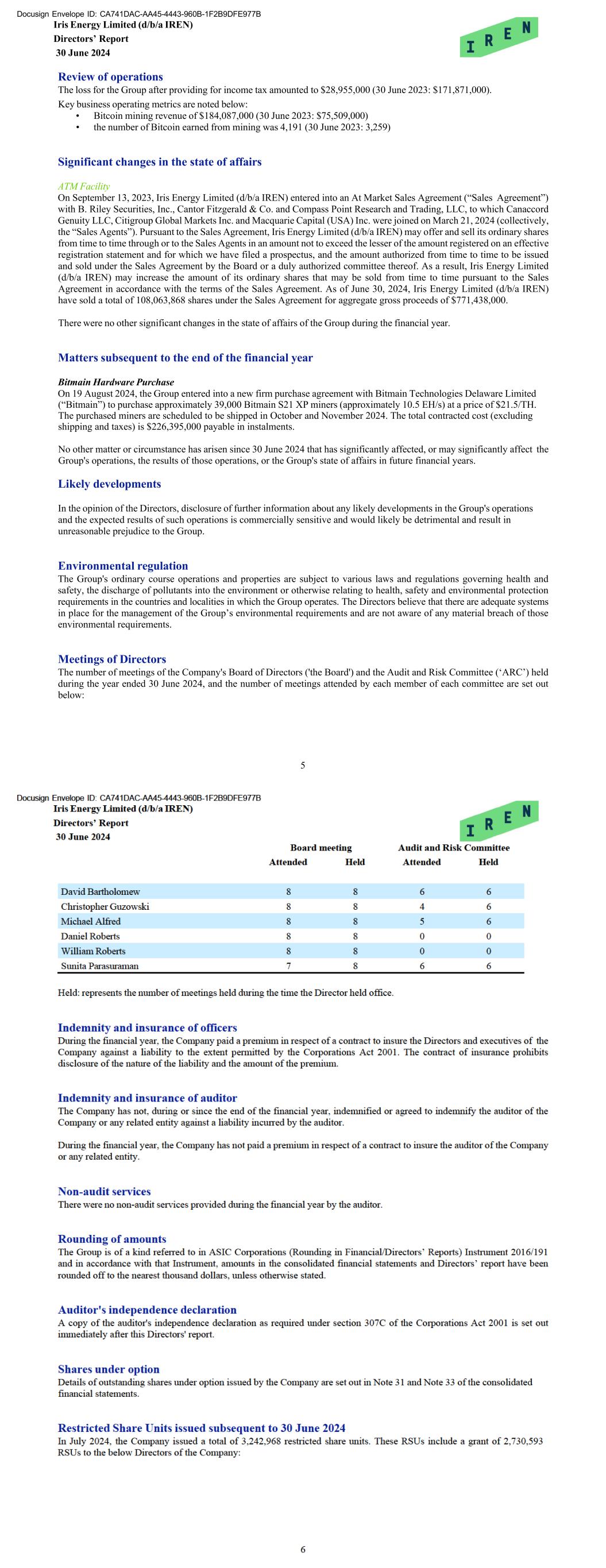
Docusign Envelope ID: CA741DAC-AA45-4443-960B-1F2B9DFE977B Iris Energy Limited (d/b/a IREN) Directors’ Report 30 June 2024 5 Review of operations The loss for the Group after providing for income tax amounted to $28,955,000 (30 June 2023: $171,871,000). Key business operating metrics are noted below: • Bitcoin mining revenue of $184,087,000 (30 June 2023: $75,509,000) • the number of Bitcoin earned from mining was 4,191 (30 June 2023: 3,259) Significant changes in the state of affairs ATM Facility On September 13, 2023, Iris Energy Limited (d/b/a IREN) entered into an At Market Sales Agreement (“Sales Agreement”) with B. Riley Securities, Inc., Cantor Fitzgerald & Co. and Compass Point Research and Trading, LLC, to which Canaccord Genuity LLC, Citigroup Global Markets Inc. and Macquarie Capital (USA) Inc. were joined on March 21, 2024 (collectively, the “Sales Agents”). Pursuant to the Sales Agreement, Iris Energy Limited (d/b/a IREN) may offer and sell its ordinary shares from time to time through or to the Sales Agents in an amount not to exceed the lesser of the amount registered on an effective registration statement and for which we have filed a prospectus, and the amount authorized from time to time to be issued and sold under the Sales Agreement by the Board or a duly authorized committee thereof. As a result, Iris Energy Limited (d/b/a IREN) may increase the amount of its ordinary shares that may be sold from time to time pursuant to the Sales Agreement in accordance with the terms of the Sales Agreement. As of June 30, 2024, Iris Energy Limited (d/b/a IREN) have sold a total of 108,063,868 shares under the Sales Agreement for aggregate gross proceeds of $771,438,000. There were no other significant changes in the state of affairs of the Group during the financial year. Matters subsequent to the end of the financial year Bitmain Hardware Purchase On 19 August 2024, the Group entered into a new firm purchase agreement with Bitmain Technologies Delaware Limited (“Bitmain”) to purchase approximately 39,000 Bitmain S21 XP miners (approximately 10.5 EH/s) at a price of $21.5/TH. The purchased miners are scheduled to be shipped in October and November 2024. The total contracted cost (excluding shipping and taxes) is $226,395,000 payable in instalments. No other matter or circumstance has arisen since 30 June 2024 that has significantly affected, or may significantly affect the Group's operations, the results of those operations, or the Group's state of affairs in future financial years. Likely developments In the opinion of the Directors, disclosure of further information about any likely developments in the Group's operations and the expected results of such operations is commercially sensitive and would likely be detrimental and result in unreasonable prejudice to the Group. Environmental regulation The Group's ordinary course operations and properties are subject to various laws and regulations governing health and safety, the discharge of pollutants into the environment or otherwise relating to health, safety and environmental protection requirements in the countries and localities in which the Group operates. The Directors believe that there are adequate systems in place for the management of the Group’s environmental requirements and are not aware of any material breach of those environmental requirements. Meetings of Directors The number of meetings of the Company's Board of Directors ('the Board') and the Audit and Risk Committee (‘ARC’) held during the year ended 30 June 2024, and the number of meetings attended by each member of each committee are set out below:
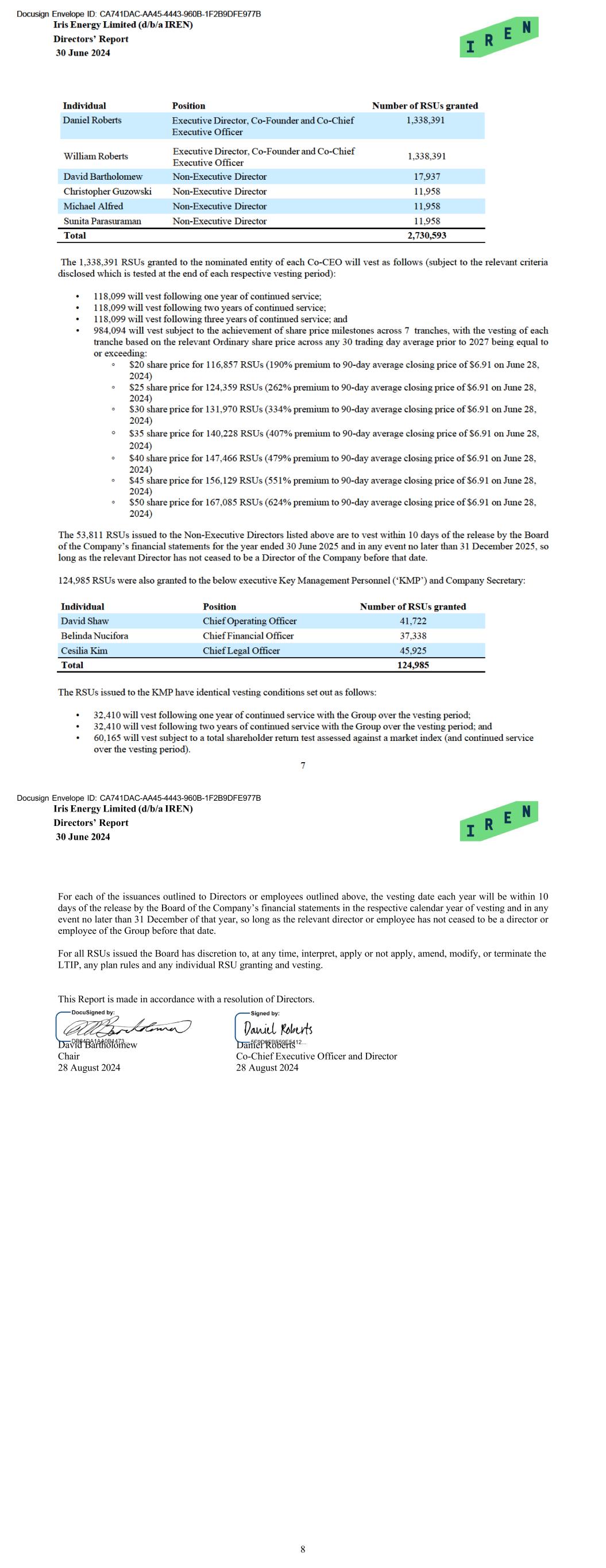
Docusign Envelope ID: CA741DAC-AA45-4443-960B-1F2B9DFE977B Iris Energy Limited (d/b/a IREN) Directors’ Report 30 June 2024 8 For each of the issuances outlined to Directors or employees outlined above, the vesting date each year will be within 10 days of the release by the Board of the Company’s financial statements in the respective calendar year of vesting and in any event no later than 31 December of that year, so long as the relevant director or employee has not ceased to be a director or employee of the Group before that date. For all RSUs issued the Board has discretion to, at any time, interpret, apply or not apply, amend, modify, or terminate the LTIP, any plan rules and any individual RSU granting and vesting. This Report is made in accordance with a resolution of Directors. David Bartholomew Chair Co-Chief Executive Officer and Director 28 August 2024 28 August 2024 Daniel Roberts
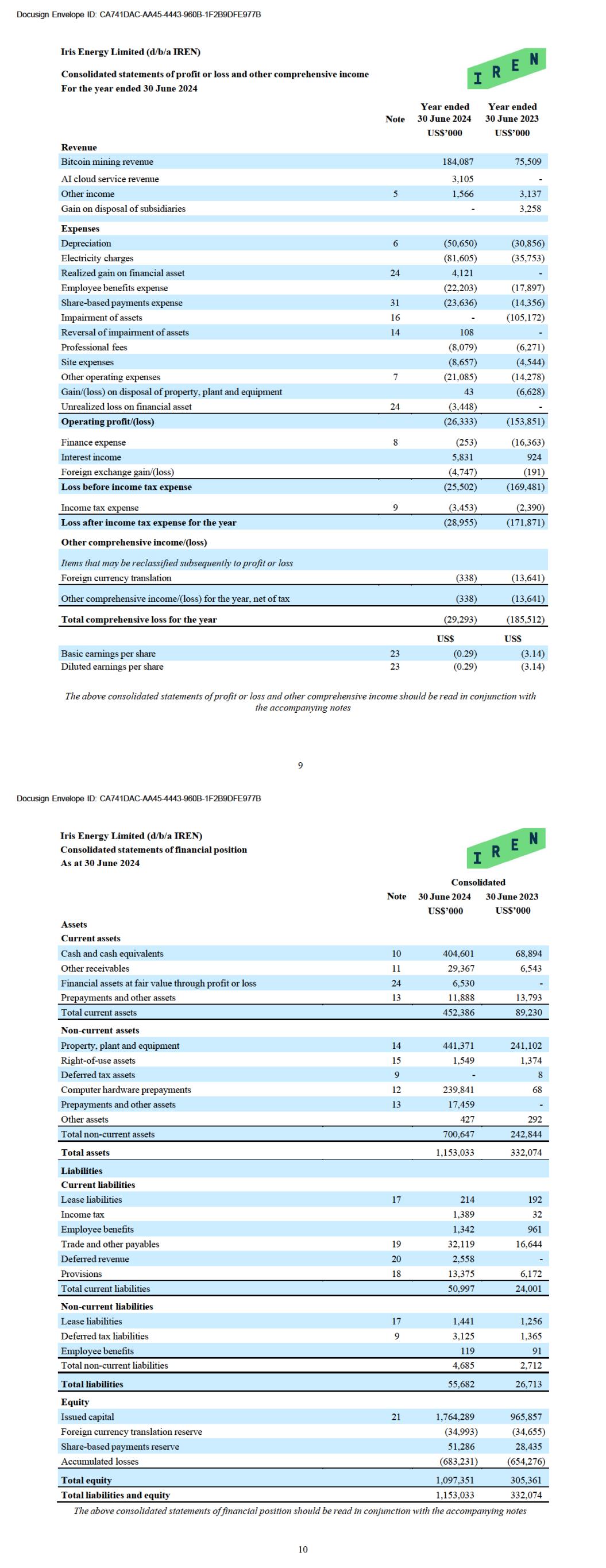
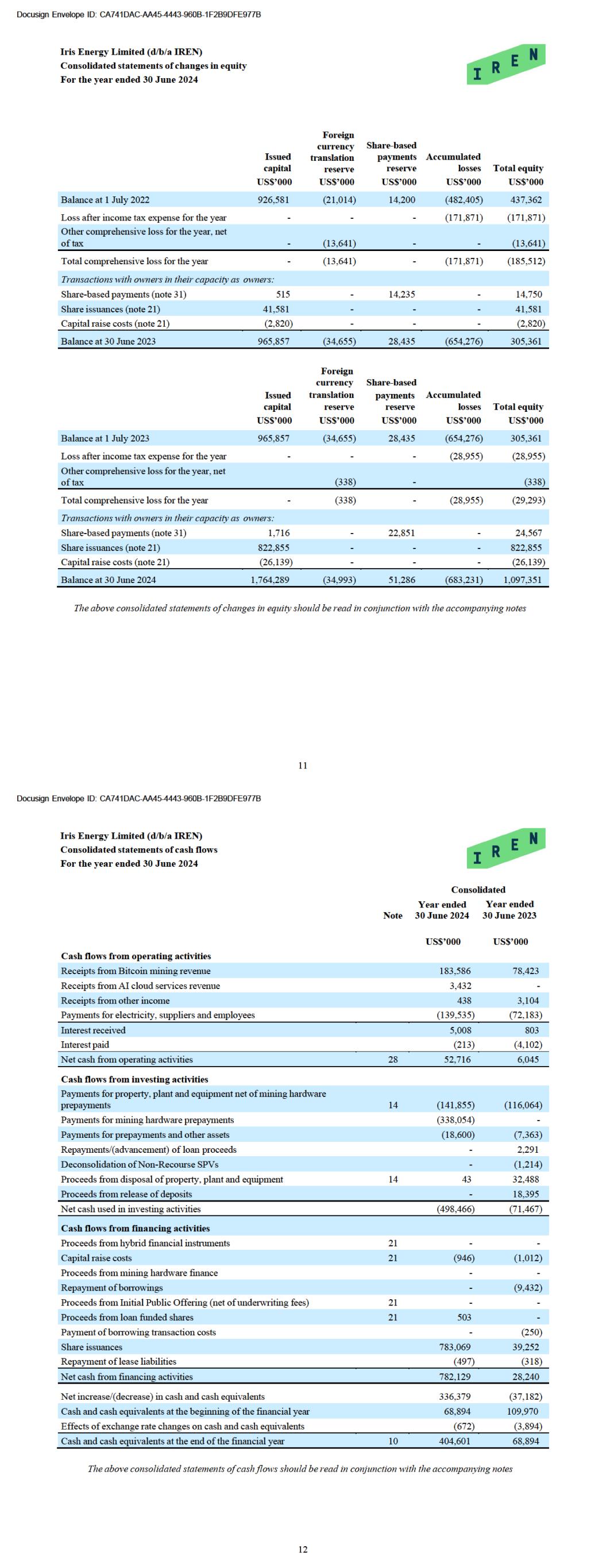
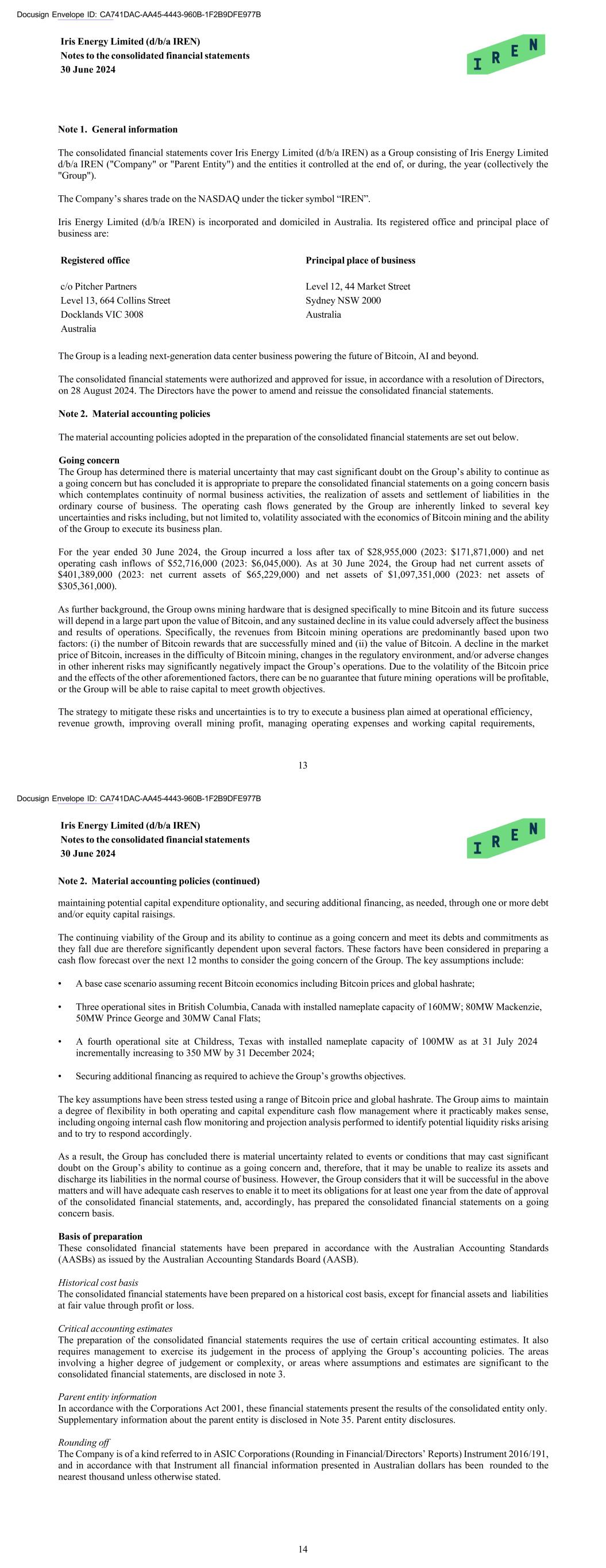
Docusign Envelope ID: CA741DAC-AA45-4443-960B-1F2B9DFE977B Iris Energy Limited (d/b/a IREN) Notes to the consolidated financial statements 30 June 2024 13 Note 1. General information The consolidated financial statements cover Iris Energy Limited (d/b/a IREN) as a Group consisting of Iris Energy Limited d/b/a IREN ("Company" or "Parent Entity") and the entities it controlled at the end of, or during, the year (collectively the "Group"). The Company’s shares trade on the NASDAQ under the ticker symbol “IREN”. Iris Energy Limited (d/b/a IREN) is incorporated and domiciled in Australia. Its registered office and principal place of business are: Registered office Principal place of business c/o Pitcher Partners Level 12, 44 Market Street Level 13, 664 Collins Street Sydney NSW 2000 Docklands VIC 3008 Australia Australia The Group is a leading next-generation data center business powering the future of Bitcoin, AI and beyond. The consolidated financial statements were authorized and approved for issue, in accordance with a resolution of Directors, on 28 August 2024. The Directors have the power to amend and reissue the consolidated financial statements. Note 2. Material accounting policies The material accounting policies adopted in the preparation of the consolidated financial statements are set out below. Going concern The Group has determined there is material uncertainty that may cast significant doubt on the Group’s ability to continue as a going concern but has concluded it is appropriate to prepare the consolidated financial statements on a going concern basis which contemplates continuity of normal business activities, the realization of assets and settlement of liabilities in the ordinary course of business. The operating cash flows generated by the Group are inherently linked to several key uncertainties and risks including, but not limited to, volatility associated with the economics of Bitcoin mining and the ability of the Group to execute its business plan. For the year ended 30 June 2024, the Group incurred a loss after tax of $28,955,000 (2023: $171,871,000) and net operating cash inflows of $52,716,000 (2023: $6,045,000). As at 30 June 2024, the Group had net current assets of $401,389,000 (2023: net current assets of $65,229,000) and net assets of $1,097,351,000 (2023: net assets of $305,361,000). As further background, the Group owns mining hardware that is designed specifically to mine Bitcoin and its future success will depend in a large part upon the value of Bitcoin, and any sustained decline in its value could adversely affect the business and results of operations. Specifically, the revenues from Bitcoin mining operations are predominantly based upon two factors: (i) the number of Bitcoin rewards that are successfully mined and (ii) the value of Bitcoin. A decline in the market price of Bitcoin, increases in the difficulty of Bitcoin mining, changes in the regulatory environment, and/or adverse changes in other inherent risks may significantly negatively impact the Group’s operations. Due to the volatility of the Bitcoin price and the effects of the other aforementioned factors, there can be no guarantee that future mining operations will be profitable, or the Group will be able to raise capital to meet growth objectives. The strategy to mitigate these risks and uncertainties is to try to execute a business plan aimed at operational efficiency, revenue growth, improving overall mining profit, managing operating expenses and working capital requirements, Docusign Envelope ID: CA741DAC-AA45-4443-960B-1F2B9DFE977B Iris Energy Limited (d/b/a IREN) Notes to the consolidated financial statements 30 June 2024 Note 2. Material accounting policies (continued) 14 maintaining potential capital expenditure optionality, and securing additional financing, as needed, through one or more debt and/or equity capital raisings. The continuing viability of the Group and its ability to continue as a going concern and meet its debts and commitments as they fall due are therefore significantly dependent upon several factors. These factors have been considered in preparing a cash flow forecast over the next 12 months to consider the going concern of the Group. The key assumptions include: • A base case scenario assuming recent Bitcoin economics including Bitcoin prices and global hashrate; • Three operational sites in British Columbia, Canada with installed nameplate capacity of 160MW; 80MW Mackenzie, 50MW Prince George and 30MW Canal Flats; • A fourth operational site at Childress, Texas with installed nameplate capacity of 100MW as at 31 July 2024 incrementally increasing to 350 MW by 31 December 2024; • Securing additional financing as required to achieve the Group’s growths objectives. The key assumptions have been stress tested using a range of Bitcoin price and global hashrate. The Group aims to maintain a degree of flexibility in both operating and capital expenditure cash flow management where it practicably makes sense, including ongoing internal cash flow monitoring and projection analysis performed to identify potential liquidity risks arising and to try to respond accordingly. As a result, the Group has concluded there is material uncertainty related to events or conditions that may cast significant doubt on the Group’s ability to continue as a going concern and, therefore, that it may be unable to realize its assets and discharge its liabilities in the normal course of business. However, the Group considers that it will be successful in the above matters and will have adequate cash reserves to enable it to meet its obligations for at least one year from the date of approval of the consolidated financial statements, and, accordingly, has prepared the consolidated financial statements on a going concern basis. Basis of preparation These consolidated financial statements have been prepared in accordance with the Australian Accounting Standards (AASBs) as issued by the Australian Accounting Standards Board (AASB). Historical cost basis The consolidated financial statements have been prepared on a historical cost basis, except for financial assets and liabilities at fair value through profit or loss. Critical accounting estimates The preparation of the consolidated financial statements requires the use of certain critical accounting estimates. It also requires management to exercise its judgement in the process of applying the Group’s accounting policies. The areas involving a higher degree of judgement or complexity, or areas where assumptions and estimates are significant to the consolidated financial statements, are disclosed in note 3. Parent entity information In accordance with the Corporations Act 2001, these financial statements present the results of the consolidated entity only. Supplementary information about the parent entity is disclosed in Note 35. Parent entity disclosures. Rounding off The Company is of a kind referred to in ASIC Corporations (Rounding in Financial/Directors’ Reports) Instrument 2016/191, and in accordance with that Instrument all financial information presented in Australian dollars has been rounded to the nearest thousand unless otherwise stated.
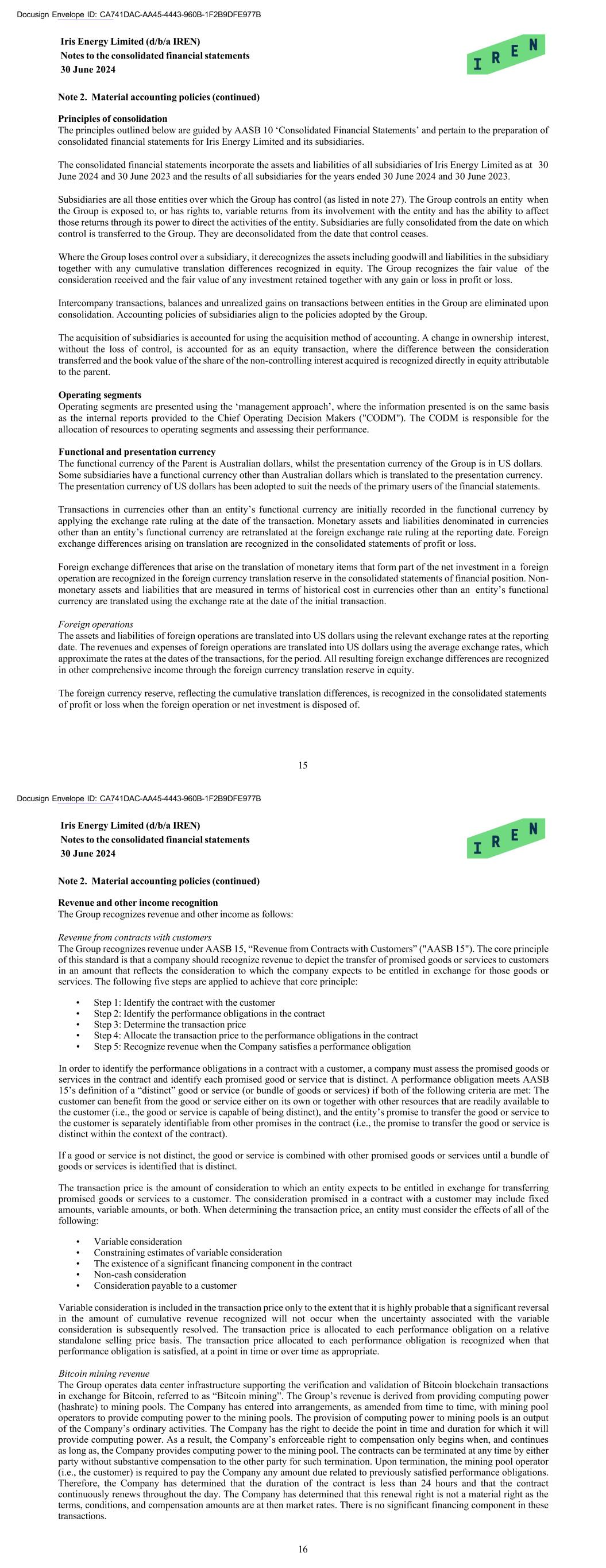
Docusign Envelope ID: CA741DAC-AA45-4443-960B-1F2B9DFE977B Iris Energy Limited (d/b/a IREN) Notes to the consolidated financial statements 30 June 2024 Note 2. Material accounting policies (continued) 15 Principles of consolidation The principles outlined below are guided by AASB 10 ‘Consolidated Financial Statements’ and pertain to the preparation of consolidated financial statements for Iris Energy Limited and its subsidiaries. The consolidated financial statements incorporate the assets and liabilities of all subsidiaries of Iris Energy Limited as at 30 June 2024 and 30 June 2023 and the results of all subsidiaries for the years ended 30 June 2024 and 30 June 2023. Subsidiaries are all those entities over which the Group has control (as listed in note 27). The Group controls an entity when the Group is exposed to, or has rights to, variable returns from its involvement with the entity and has the ability to affect those returns through its power to direct the activities of the entity. Subsidiaries are fully consolidated from the date on which control is transferred to the Group. They are deconsolidated from the date that control ceases. Where the Group loses control over a subsidiary, it derecognizes the assets including goodwill and liabilities in the subsidiary together with any cumulative translation differences recognized in equity. The Group recognizes the fair value of the consideration received and the fair value of any investment retained together with any gain or loss in profit or loss. Intercompany transactions, balances and unrealized gains on transactions between entities in the Group are eliminated upon consolidation. Accounting policies of subsidiaries align to the policies adopted by the Group. The acquisition of subsidiaries is accounted for using the acquisition method of accounting. A change in ownership interest, without the loss of control, is accounted for as an equity transaction, where the difference between the consideration transferred and the book value of the share of the non-controlling interest acquired is recognized directly in equity attributable to the parent. Operating segments Operating segments are presented using the ‘management approach’, where the information presented is on the same basis as the internal reports provided to the Chief Operating Decision Makers ("CODM"). The CODM is responsible for the allocation of resources to operating segments and assessing their performance. Functional and presentation currency The functional currency of the Parent is Australian dollars, whilst the presentation currency of the Group is in US dollars. Some subsidiaries have a functional currency other than Australian dollars which is translated to the presentation currency. The presentation currency of US dollars has been adopted to suit the needs of the primary users of the financial statements. Transactions in currencies other than an entity’s functional currency are initially recorded in the functional currency by applying the exchange rate ruling at the date of the transaction. Monetary assets and liabilities denominated in currencies other than an entity’s functional currency are retranslated at the foreign exchange rate ruling at the reporting date. Foreign exchange differences arising on translation are recognized in the consolidated statements of profit or loss. Foreign exchange differences that arise on the translation of monetary items that form part of the net investment in a foreign operation are recognized in the foreign currency translation reserve in the consolidated statements of financial position. Non- monetary assets and liabilities that are measured in terms of historical cost in currencies other than an entity’s functional currency are translated using the exchange rate at the date of the initial transaction. Foreign operations The assets and liabilities of foreign operations are translated into US dollars using the relevant exchange rates at the reporting date. The revenues and expenses of foreign operations are translated into US dollars using the average exchange rates, which approximate the rates at the dates of the transactions, for the period. All resulting foreign exchange differences are recognized in other comprehensive income through the foreign currency translation reserve in equity. The foreign currency reserve, reflecting the cumulative translation differences, is recognized in the consolidated statements of profit or loss when the foreign operation or net investment is disposed of. Docusign Envelope ID: CA741DAC-AA45-4443-960B-1F2B9DFE977B Iris Energy Limited (d/b/a IREN) Notes to the consolidated financial statements 30 June 2024 Note 2. Material accounting policies (continued) 16 Revenue and other income recognition The Group recognizes revenue and other income as follows: Revenue from contracts with customers The Group recognizes revenue under AASB 15, “Revenue from Contracts with Customers” ("AASB 15"). The core principle of this standard is that a company should recognize revenue to depict the transfer of promised goods or services to customers in an amount that reflects the consideration to which the company expects to be entitled in exchange for those goods or services. The following five steps are applied to achieve that core principle: • Step 1: Identify the contract with the customer • Step 2: Identify the performance obligations in the contract • Step 3: Determine the transaction price • Step 4: Allocate the transaction price to the performance obligations in the contract • Step 5: Recognize revenue when the Company satisfies a performance obligation In order to identify the performance obligations in a contract with a customer, a company must assess the promised goods or services in the contract and identify each promised good or service that is distinct. A performance obligation meets AASB 15’s definition of a “distinct” good or service (or bundle of goods or services) if both of the following criteria are met: The customer can benefit from the good or service either on its own or together with other resources that are readily available to the customer (i.e., the good or service is capable of being distinct), and the entity’s promise to transfer the good or service to the customer is separately identifiable from other promises in the contract (i.e., the promise to transfer the good or service is distinct within the context of the contract). If a good or service is not distinct, the good or service is combined with other promised goods or services until a bundle of goods or services is identified that is distinct. The transaction price is the amount of consideration to which an entity expects to be entitled in exchange for transferring promised goods or services to a customer. The consideration promised in a contract with a customer may include fixed amounts, variable amounts, or both. When determining the transaction price, an entity must consider the effects of all of the following: • Variable consideration • Constraining estimates of variable consideration • The existence of a significant financing component in the contract • Non-cash consideration • Consideration payable to a customer Variable consideration is included in the transaction price only to the extent that it is highly probable that a significant reversal in the amount of cumulative revenue recognized will not occur when the uncertainty associated with the variable consideration is subsequently resolved. The transaction price is allocated to each performance obligation on a relative standalone selling price basis. The transaction price allocated to each performance obligation is recognized when that performance obligation is satisfied, at a point in time or over time as appropriate. Bitcoin mining revenue The Group operates data center infrastructure supporting the verification and validation of Bitcoin blockchain transactions in exchange for Bitcoin, referred to as “Bitcoin mining”. The Group’s revenue is derived from providing computing power (hashrate) to mining pools. The Company has entered into arrangements, as amended from time to time, with mining pool operators to provide computing power to the mining pools. The provision of computing power to mining pools is an output of the Company’s ordinary activities. The Company has the right to decide the point in time and duration for which it will provide computing power. As a result, the Company’s enforceable right to compensation only begins when, and continues as long as, the Company provides computing power to the mining pool. The contracts can be terminated at any time by either party without substantive compensation to the other party for such termination. Upon termination, the mining pool operator (i.e., the customer) is required to pay the Company any amount due related to previously satisfied performance obligations. Therefore, the Company has determined that the duration of the contract is less than 24 hours and that the contract continuously renews throughout the day. The Company has determined that this renewal right is not a material right as the terms, conditions, and compensation amounts are at then market rates. There is no significant financing component in these transactions.
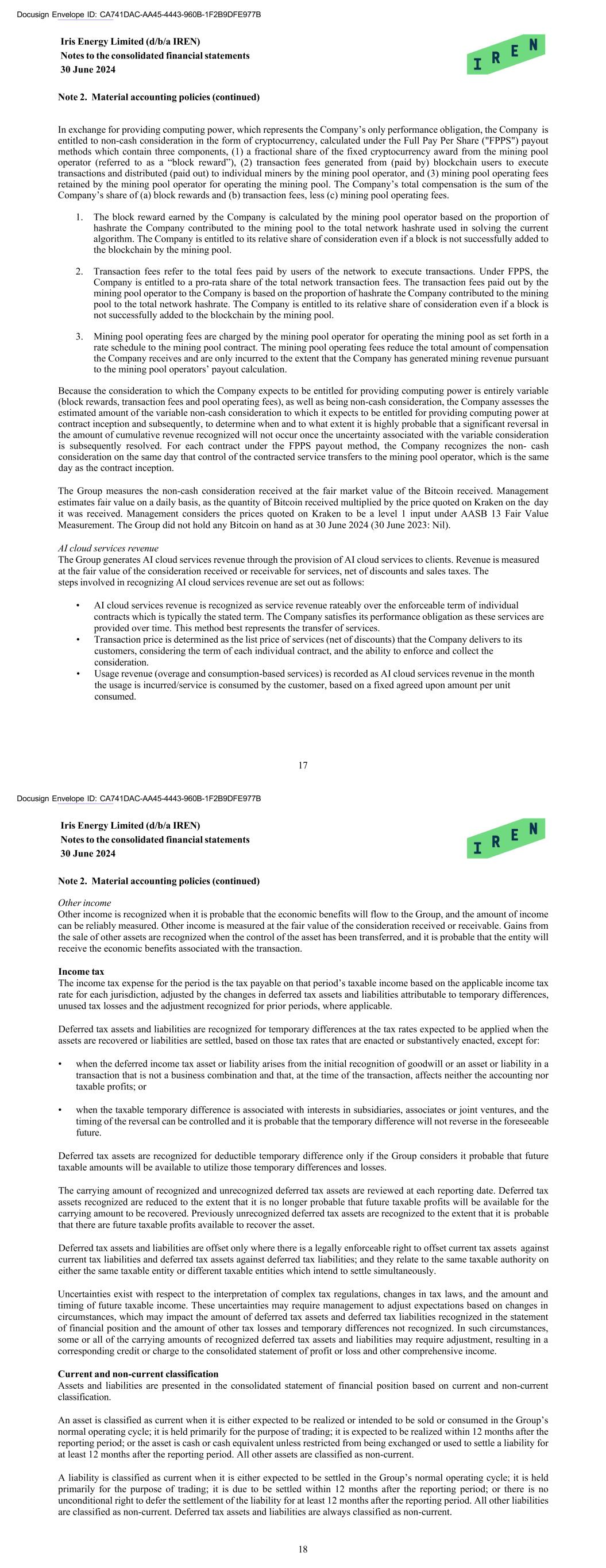
Docusign Envelope ID: CA741DAC-AA45-4443-960B-1F2B9DFE977B Iris Energy Limited (d/b/a IREN) Notes to the consolidated financial statements 30 June 2024 Note 2. Material accounting policies (continued) 17 In exchange for providing computing power, which represents the Company’s only performance obligation, the Company is entitled to non-cash consideration in the form of cryptocurrency, calculated under the Full Pay Per Share ("FPPS") payout methods which contain three components, (1) a fractional share of the fixed cryptocurrency award from the mining pool operator (referred to as a “block reward”), (2) transaction fees generated from (paid by) blockchain users to execute transactions and distributed (paid out) to individual miners by the mining pool operator, and (3) mining pool operating fees retained by the mining pool operator for operating the mining pool. The Company’s total compensation is the sum of the Company’s share of (a) block rewards and (b) transaction fees, less (c) mining pool operating fees. 1. The block reward earned by the Company is calculated by the mining pool operator based on the proportion of hashrate the Company contributed to the mining pool to the total network hashrate used in solving the current algorithm. The Company is entitled to its relative share of consideration even if a block is not successfully added to the blockchain by the mining pool. 2. Transaction fees refer to the total fees paid by users of the network to execute transactions. Under FPPS, the Company is entitled to a pro-rata share of the total network transaction fees. The transaction fees paid out by the mining pool operator to the Company is based on the proportion of hashrate the Company contributed to the mining pool to the total network hashrate. The Company is entitled to its relative share of consideration even if a block is not successfully added to the blockchain by the mining pool. 3. Mining pool operating fees are charged by the mining pool operator for operating the mining pool as set forth in a rate schedule to the mining pool contract. The mining pool operating fees reduce the total amount of compensation the Company receives and are only incurred to the extent that the Company has generated mining revenue pursuant to the mining pool operators’ payout calculation. Because the consideration to which the Company expects to be entitled for providing computing power is entirely variable (block rewards, transaction fees and pool operating fees), as well as being non-cash consideration, the Company assesses the estimated amount of the variable non-cash consideration to which it expects to be entitled for providing computing power at contract inception and subsequently, to determine when and to what extent it is highly probable that a significant reversal in the amount of cumulative revenue recognized will not occur once the uncertainty associated with the variable consideration is subsequently resolved. For each contract under the FPPS payout method, the Company recognizes the non- cash consideration on the same day that control of the contracted service transfers to the mining pool operator, which is the same day as the contract inception. The Group measures the non-cash consideration received at the fair market value of the Bitcoin received. Management estimates fair value on a daily basis, as the quantity of Bitcoin received multiplied by the price quoted on Kraken on the day it was received. Management considers the prices quoted on Kraken to be a level 1 input under AASB 13 Fair Value Measurement. The Group did not hold any Bitcoin on hand as at 30 June 2024 (30 June 2023: Nil). AI cloud services revenue The Group generates AI cloud services revenue through the provision of AI cloud services to clients. Revenue is measured at the fair value of the consideration received or receivable for services, net of discounts and sales taxes. The steps involved in recognizing AI cloud services revenue are set out as follows: • AI cloud services revenue is recognized as service revenue rateably over the enforceable term of individual contracts which is typically the stated term. The Company satisfies its performance obligation as these services are provided over time. This method best represents the transfer of services. • Transaction price is determined as the list price of services (net of discounts) that the Company delivers to its customers, considering the term of each individual contract, and the ability to enforce and collect the consideration. • Usage revenue (overage and consumption-based services) is recorded as AI cloud services revenue in the month the usage is incurred/service is consumed by the customer, based on a fixed agreed upon amount per unit consumed. Docusign Envelope ID: CA741DAC-AA45-4443-960B-1F2B9DFE977B Iris Energy Limited (d/b/a IREN) Notes to the consolidated financial statements 30 June 2024 Note 2. Material accounting policies (continued) 18 Other income Other income is recognized when it is probable that the economic benefits will flow to the Group, and the amount of income can be reliably measured. Other income is measured at the fair value of the consideration received or receivable. Gains from the sale of other assets are recognized when the control of the asset has been transferred, and it is probable that the entity will receive the economic benefits associated with the transaction. Income tax The income tax expense for the period is the tax payable on that period’s taxable income based on the applicable income tax rate for each jurisdiction, adjusted by the changes in deferred tax assets and liabilities attributable to temporary differences, unused tax losses and the adjustment recognized for prior periods, where applicable. Deferred tax assets and liabilities are recognized for temporary differences at the tax rates expected to be applied when the assets are recovered or liabilities are settled, based on those tax rates that are enacted or substantively enacted, except for: • when the deferred income tax asset or liability arises from the initial recognition of goodwill or an asset or liability in a transaction that is not a business combination and that, at the time of the transaction, affects neither the accounting nor taxable profits; or • when the taxable temporary difference is associated with interests in subsidiaries, associates or joint ventures, and the timing of the reversal can be controlled and it is probable that the temporary difference will not reverse in the foreseeable future. Deferred tax assets are recognized for deductible temporary difference only if the Group considers it probable that future taxable amounts will be available to utilize those temporary differences and losses. The carrying amount of recognized and unrecognized deferred tax assets are reviewed at each reporting date. Deferred tax assets recognized are reduced to the extent that it is no longer probable that future taxable profits will be available for the carrying amount to be recovered. Previously unrecognized deferred tax assets are recognized to the extent that it is probable that there are future taxable profits available to recover the asset. Deferred tax assets and liabilities are offset only where there is a legally enforceable right to offset current tax assets against current tax liabilities and deferred tax assets against deferred tax liabilities; and they relate to the same taxable authority on either the same taxable entity or different taxable entities which intend to settle simultaneously. Uncertainties exist with respect to the interpretation of complex tax regulations, changes in tax laws, and the amount and timing of future taxable income. These uncertainties may require management to adjust expectations based on changes in circumstances, which may impact the amount of deferred tax assets and deferred tax liabilities recognized in the statement of financial position and the amount of other tax losses and temporary differences not recognized. In such circumstances, some or all of the carrying amounts of recognized deferred tax assets and liabilities may require adjustment, resulting in a corresponding credit or charge to the consolidated statement of profit or loss and other comprehensive income. Current and non-current classification Assets and liabilities are presented in the consolidated statement of financial position based on current and non-current classification. An asset is classified as current when it is either expected to be realized or intended to be sold or consumed in the Group’s normal operating cycle; it is held primarily for the purpose of trading; it is expected to be realized within 12 months after the reporting period; or the asset is cash or cash equivalent unless restricted from being exchanged or used to settle a liability for at least 12 months after the reporting period. All other assets are classified as non-current. A liability is classified as current when it is either expected to be settled in the Group’s normal operating cycle; it is held primarily for the purpose of trading; it is due to be settled within 12 months after the reporting period; or there is no unconditional right to defer the settlement of the liability for at least 12 months after the reporting period. All other liabilities are classified as non-current. Deferred tax assets and liabilities are always classified as non-current.
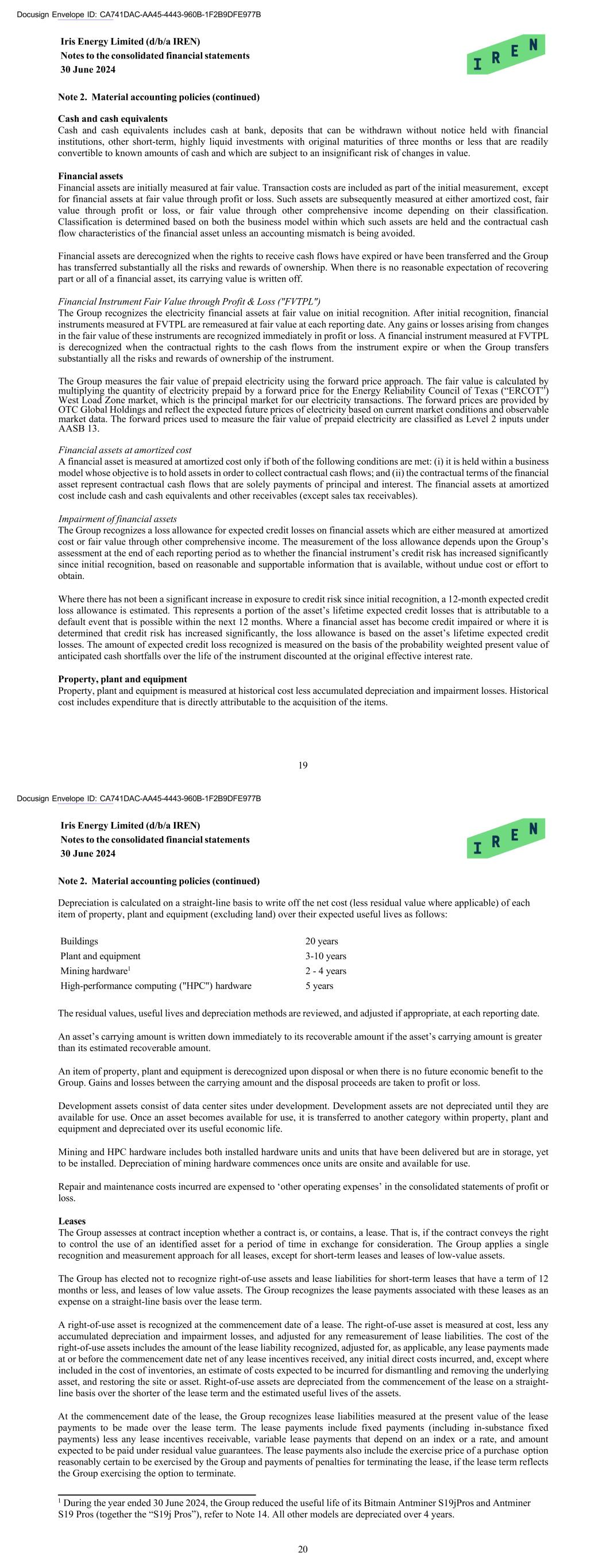
Docusign Envelope ID: CA741DAC-AA45-4443-960B-1F2B9DFE977B Iris Energy Limited (d/b/a IREN) Notes to the consolidated financial statements 30 June 2024 Note 2. Material accounting policies (continued) 19 Cash and cash equivalents Cash and cash equivalents includes cash at bank, deposits that can be withdrawn without notice held with financial institutions, other short-term, highly liquid investments with original maturities of three months or less that are readily convertible to known amounts of cash and which are subject to an insignificant risk of changes in value. Financial assets Financial assets are initially measured at fair value. Transaction costs are included as part of the initial measurement, except for financial assets at fair value through profit or loss. Such assets are subsequently measured at either amortized cost, fair value through profit or loss, or fair value through other comprehensive income depending on their classification. Classification is determined based on both the business model within which such assets are held and the contractual cash flow characteristics of the financial asset unless an accounting mismatch is being avoided. Financial assets are derecognized when the rights to receive cash flows have expired or have been transferred and the Group has transferred substantially all the risks and rewards of ownership. When there is no reasonable expectation of recovering part or all of a financial asset, its carrying value is written off. Financial Instrument Fair Value through Profit & Loss ("FVTPL") The Group recognizes the electricity financial assets at fair value on initial recognition. After initial recognition, financial instruments measured at FVTPL are remeasured at fair value at each reporting date. Any gains or losses arising from changes in the fair value of these instruments are recognized immediately in profit or loss. A financial instrument measured at FVTPL is derecognized when the contractual rights to the cash flows from the instrument expire or when the Group transfers substantially all the risks and rewards of ownership of the instrument. The Group measures the fair value of prepaid electricity using the forward price approach. The fair value is calculated by multiplying the quantity of electricity prepaid by a forward price for the Energy Reliability Council of Texas (“ERCOT”) West Load Zone market, which is the principal market for our electricity transactions. The forward prices are provided by OTC Global Holdings and reflect the expected future prices of electricity based on current market conditions and observable market data. The forward prices used to measure the fair value of prepaid electricity are classified as Level 2 inputs under AASB 13. Financial assets at amortized cost A financial asset is measured at amortized cost only if both of the following conditions are met: (i) it is held within a business model whose objective is to hold assets in order to collect contractual cash flows; and (ii) the contractual terms of the financial asset represent contractual cash flows that are solely payments of principal and interest. The financial assets at amortized cost include cash and cash equivalents and other receivables (except sales tax receivables). Impairment of financial assets The Group recognizes a loss allowance for expected credit losses on financial assets which are either measured at amortized cost or fair value through other comprehensive income. The measurement of the loss allowance depends upon the Group’s assessment at the end of each reporting period as to whether the financial instrument’s credit risk has increased significantly since initial recognition, based on reasonable and supportable information that is available, without undue cost or effort to obtain. Where there has not been a significant increase in exposure to credit risk since initial recognition, a 12-month expected credit loss allowance is estimated. This represents a portion of the asset’s lifetime expected credit losses that is attributable to a default event that is possible within the next 12 months. Where a financial asset has become credit impaired or where it is determined that credit risk has increased significantly, the loss allowance is based on the asset’s lifetime expected credit losses. The amount of expected credit loss recognized is measured on the basis of the probability weighted present value of anticipated cash shortfalls over the life of the instrument discounted at the original effective interest rate. Property, plant and equipment Property, plant and equipment is measured at historical cost less accumulated depreciation and impairment losses. Historical cost includes expenditure that is directly attributable to the acquisition of the items. Docusign Envelope ID: CA741DAC-AA45-4443-960B-1F2B9DFE977B Iris Energy Limited (d/b/a IREN) Notes to the consolidated financial statements 30 June 2024 Note 2. Material accounting policies (continued) 20 Depreciation is calculated on a straight-line basis to write off the net cost (less residual value where applicable) of each item of property, plant and equipment (excluding land) over their expected useful lives as follows: Buildings 20 years Plant and equipment 3-10 years Mining hardware1 2 - 4 years High-performance computing ("HPC") hardware 5 years The residual values, useful lives and depreciation methods are reviewed, and adjusted if appropriate, at each reporting date. An asset’s carrying amount is written down immediately to its recoverable amount if the asset’s carrying amount is greater than its estimated recoverable amount. An item of property, plant and equipment is derecognized upon disposal or when there is no future economic benefit to the Group. Gains and losses between the carrying amount and the disposal proceeds are taken to profit or loss. Development assets consist of data center sites under development. Development assets are not depreciated until they are available for use. Once an asset becomes available for use, it is transferred to another category within property, plant and equipment and depreciated over its useful economic life. Mining and HPC hardware includes both installed hardware units and units that have been delivered but are in storage, yet to be installed. Depreciation of mining hardware commences once units are onsite and available for use. Repair and maintenance costs incurred are expensed to ‘other operating expenses’ in the consolidated statements of profit or loss. Leases The Group assesses at contract inception whether a contract is, or contains, a lease. That is, if the contract conveys the right to control the use of an identified asset for a period of time in exchange for consideration. The Group applies a single recognition and measurement approach for all leases, except for short-term leases and leases of low-value assets. The Group has elected not to recognize right-of-use assets and lease liabilities for short-term leases that have a term of 12 months or less, and leases of low value assets. The Group recognizes the lease payments associated with these leases as an expense on a straight-line basis over the lease term. A right-of-use asset is recognized at the commencement date of a lease. The right-of-use asset is measured at cost, less any accumulated depreciation and impairment losses, and adjusted for any remeasurement of lease liabilities. The cost of the right-of-use assets includes the amount of the lease liability recognized, adjusted for, as applicable, any lease payments made at or before the commencement date net of any lease incentives received, any initial direct costs incurred, and, except where included in the cost of inventories, an estimate of costs expected to be incurred for dismantling and removing the underlying asset, and restoring the site or asset. Right-of-use assets are depreciated from the commencement of the lease on a straight- line basis over the shorter of the lease term and the estimated useful lives of the assets. At the commencement date of the lease, the Group recognizes lease liabilities measured at the present value of the lease payments to be made over the lease term. The lease payments include fixed payments (including in-substance fixed payments) less any lease incentives receivable, variable lease payments that depend on an index or a rate, and amount expected to be paid under residual value guarantees. The lease payments also include the exercise price of a purchase option reasonably certain to be exercised by the Group and payments of penalties for terminating the lease, if the lease term reflects the Group exercising the option to terminate. 1 During the year ended 30 June 2024, the Group reduced the useful life of its Bitmain Antminer S19jPros and Antminer S19 Pros (together the “S19j Pros”), refer to Note 14. All other models are depreciated over 4 years.
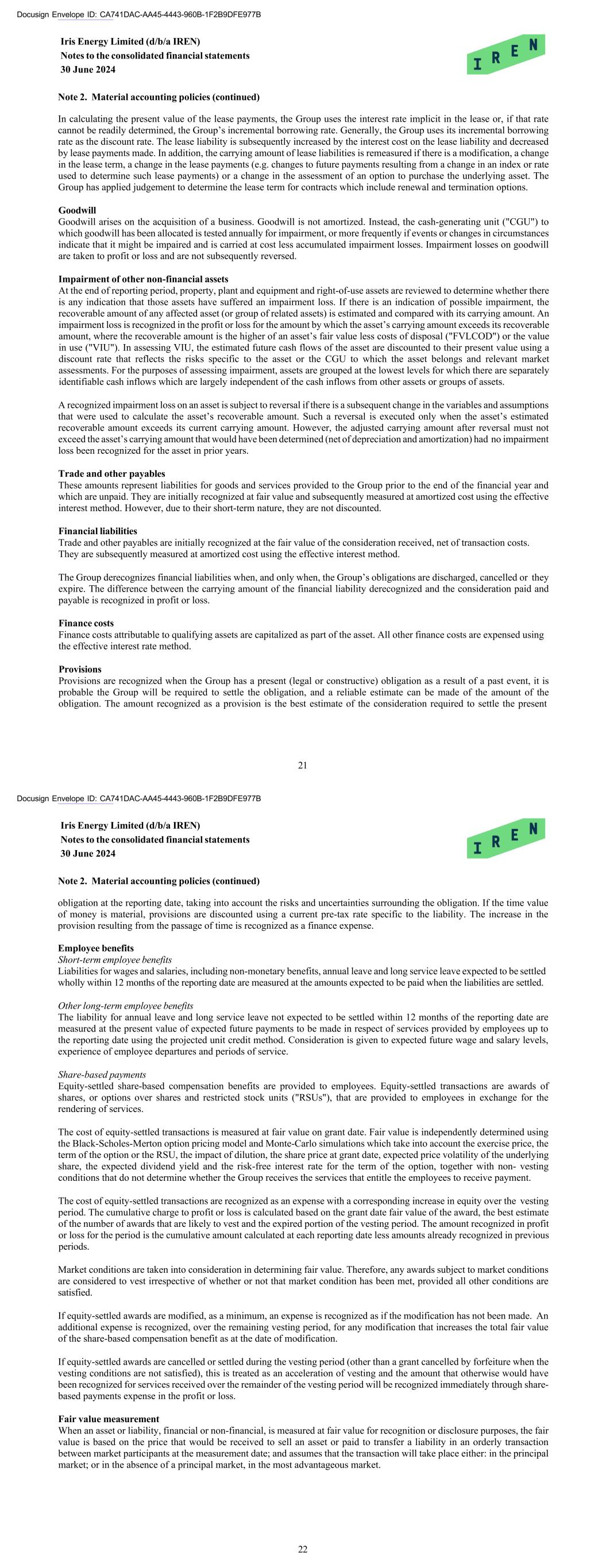
Docusign Envelope ID: CA741DAC-AA45-4443-960B-1F2B9DFE977B Iris Energy Limited (d/b/a IREN) Notes to the consolidated financial statements 30 June 2024 Note 2. Material accounting policies (continued) 21 In calculating the present value of the lease payments, the Group uses the interest rate implicit in the lease or, if that rate cannot be readily determined, the Group’s incremental borrowing rate. Generally, the Group uses its incremental borrowing rate as the discount rate. The lease liability is subsequently increased by the interest cost on the lease liability and decreased by lease payments made. In addition, the carrying amount of lease liabilities is remeasured if there is a modification, a change in the lease term, a change in the lease payments (e.g. changes to future payments resulting from a change in an index or rate used to determine such lease payments) or a change in the assessment of an option to purchase the underlying asset. The Group has applied judgement to determine the lease term for contracts which include renewal and termination options. Goodwill Goodwill arises on the acquisition of a business. Goodwill is not amortized. Instead, the cash-generating unit ("CGU") to which goodwill has been allocated is tested annually for impairment, or more frequently if events or changes in circumstances indicate that it might be impaired and is carried at cost less accumulated impairment losses. Impairment losses on goodwill are taken to profit or loss and are not subsequently reversed. Impairment of other non-financial assets At the end of reporting period, property, plant and equipment and right-of-use assets are reviewed to determine whether there is any indication that those assets have suffered an impairment loss. If there is an indication of possible impairment, the recoverable amount of any affected asset (or group of related assets) is estimated and compared with its carrying amount. An impairment loss is recognized in the profit or loss for the amount by which the asset’s carrying amount exceeds its recoverable amount, where the recoverable amount is the higher of an asset’s fair value less costs of disposal ("FVLCOD") or the value in use ("VIU"). In assessing VIU, the estimated future cash flows of the asset are discounted to their present value using a discount rate that reflects the risks specific to the asset or the CGU to which the asset belongs and relevant market assessments. For the purposes of assessing impairment, assets are grouped at the lowest levels for which there are separately identifiable cash inflows which are largely independent of the cash inflows from other assets or groups of assets. A recognized impairment loss on an asset is subject to reversal if there is a subsequent change in the variables and assumptions that were used to calculate the asset’s recoverable amount. Such a reversal is executed only when the asset’s estimated recoverable amount exceeds its current carrying amount. However, the adjusted carrying amount after reversal must not exceed the asset’s carrying amount that would have been determined (net of depreciation and amortization) had no impairment loss been recognized for the asset in prior years. Trade and other payables These amounts represent liabilities for goods and services provided to the Group prior to the end of the financial year and which are unpaid. They are initially recognized at fair value and subsequently measured at amortized cost using the effective interest method. However, due to their short-term nature, they are not discounted. Financial liabilities Trade and other payables are initially recognized at the fair value of the consideration received, net of transaction costs. They are subsequently measured at amortized cost using the effective interest method. The Group derecognizes financial liabilities when, and only when, the Group’s obligations are discharged, cancelled or they expire. The difference between the carrying amount of the financial liability derecognized and the consideration paid and payable is recognized in profit or loss. Finance costs Finance costs attributable to qualifying assets are capitalized as part of the asset. All other finance costs are expensed using the effective interest rate method. Provisions Provisions are recognized when the Group has a present (legal or constructive) obligation as a result of a past event, it is probable the Group will be required to settle the obligation, and a reliable estimate can be made of the amount of the obligation. The amount recognized as a provision is the best estimate of the consideration required to settle the present Docusign Envelope ID: CA741DAC-AA45-4443-960B-1F2B9DFE977B Iris Energy Limited (d/b/a IREN) Notes to the consolidated financial statements 30 June 2024 Note 2. Material accounting policies (continued) 22 obligation at the reporting date, taking into account the risks and uncertainties surrounding the obligation. If the time value of money is material, provisions are discounted using a current pre-tax rate specific to the liability. The increase in the provision resulting from the passage of time is recognized as a finance expense. Employee benefits Short-term employee benefits Liabilities for wages and salaries, including non-monetary benefits, annual leave and long service leave expected to be settled wholly within 12 months of the reporting date are measured at the amounts expected to be paid when the liabilities are settled. Other long-term employee benefits The liability for annual leave and long service leave not expected to be settled within 12 months of the reporting date are measured at the present value of expected future payments to be made in respect of services provided by employees up to the reporting date using the projected unit credit method. Consideration is given to expected future wage and salary levels, experience of employee departures and periods of service. Share-based payments Equity-settled share-based compensation benefits are provided to employees. Equity-settled transactions are awards of shares, or options over shares and restricted stock units ("RSUs"), that are provided to employees in exchange for the rendering of services. The cost of equity-settled transactions is measured at fair value on grant date. Fair value is independently determined using the Black-Scholes-Merton option pricing model and Monte-Carlo simulations which take into account the exercise price, the term of the option or the RSU, the impact of dilution, the share price at grant date, expected price volatility of the underlying share, the expected dividend yield and the risk-free interest rate for the term of the option, together with non- vesting conditions that do not determine whether the Group receives the services that entitle the employees to receive payment. The cost of equity-settled transactions are recognized as an expense with a corresponding increase in equity over the vesting period. The cumulative charge to profit or loss is calculated based on the grant date fair value of the award, the best estimate of the number of awards that are likely to vest and the expired portion of the vesting period. The amount recognized in profit or loss for the period is the cumulative amount calculated at each reporting date less amounts already recognized in previous periods. Market conditions are taken into consideration in determining fair value. Therefore, any awards subject to market conditions are considered to vest irrespective of whether or not that market condition has been met, provided all other conditions are satisfied. If equity-settled awards are modified, as a minimum, an expense is recognized as if the modification has not been made. An additional expense is recognized, over the remaining vesting period, for any modification that increases the total fair value of the share-based compensation benefit as at the date of modification. If equity-settled awards are cancelled or settled during the vesting period (other than a grant cancelled by forfeiture when the vesting conditions are not satisfied), this is treated as an acceleration of vesting and the amount that otherwise would have been recognized for services received over the remainder of the vesting period will be recognized immediately through share- based payments expense in the profit or loss. Fair value measurement When an asset or liability, financial or non-financial, is measured at fair value for recognition or disclosure purposes, the fair value is based on the price that would be received to sell an asset or paid to transfer a liability in an orderly transaction between market participants at the measurement date; and assumes that the transaction will take place either: in the principal market; or in the absence of a principal market, in the most advantageous market.
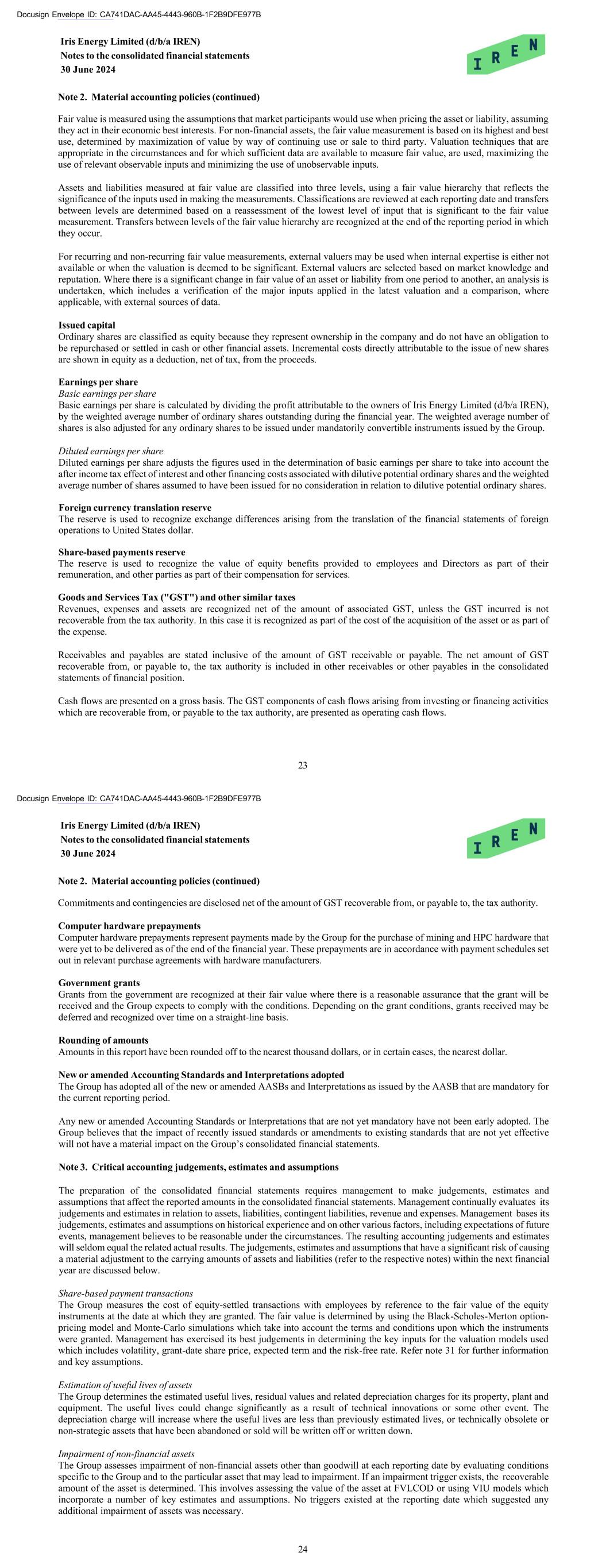
Docusign Envelope ID: CA741DAC-AA45-4443-960B-1F2B9DFE977B Iris Energy Limited (d/b/a IREN) Notes to the consolidated financial statements 30 June 2024 Note 2. Material accounting policies (continued) 23 Fair value is measured using the assumptions that market participants would use when pricing the asset or liability, assuming they act in their economic best interests. For non-financial assets, the fair value measurement is based on its highest and best use, determined by maximization of value by way of continuing use or sale to third party. Valuation techniques that are appropriate in the circumstances and for which sufficient data are available to measure fair value, are used, maximizing the use of relevant observable inputs and minimizing the use of unobservable inputs. Assets and liabilities measured at fair value are classified into three levels, using a fair value hierarchy that reflects the significance of the inputs used in making the measurements. Classifications are reviewed at each reporting date and transfers between levels are determined based on a reassessment of the lowest level of input that is significant to the fair value measurement. Transfers between levels of the fair value hierarchy are recognized at the end of the reporting period in which they occur. For recurring and non-recurring fair value measurements, external valuers may be used when internal expertise is either not available or when the valuation is deemed to be significant. External valuers are selected based on market knowledge and reputation. Where there is a significant change in fair value of an asset or liability from one period to another, an analysis is undertaken, which includes a verification of the major inputs applied in the latest valuation and a comparison, where applicable, with external sources of data. Issued capital Ordinary shares are classified as equity because they represent ownership in the company and do not have an obligation to be repurchased or settled in cash or other financial assets. Incremental costs directly attributable to the issue of new shares are shown in equity as a deduction, net of tax, from the proceeds. Earnings per share Basic earnings per share Basic earnings per share is calculated by dividing the profit attributable to the owners of Iris Energy Limited (d/b/a IREN), by the weighted average number of ordinary shares outstanding during the financial year. The weighted average number of shares is also adjusted for any ordinary shares to be issued under mandatorily convertible instruments issued by the Group. Diluted earnings per share Diluted earnings per share adjusts the figures used in the determination of basic earnings per share to take into account the after income tax effect of interest and other financing costs associated with dilutive potential ordinary shares and the weighted average number of shares assumed to have been issued for no consideration in relation to dilutive potential ordinary shares. Foreign currency translation reserve The reserve is used to recognize exchange differences arising from the translation of the financial statements of foreign operations to United States dollar. Share-based payments reserve The reserve is used to recognize the value of equity benefits provided to employees and Directors as part of their remuneration, and other parties as part of their compensation for services. Goods and Services Tax ("GST") and other similar taxes Revenues, expenses and assets are recognized net of the amount of associated GST, unless the GST incurred is not recoverable from the tax authority. In this case it is recognized as part of the cost of the acquisition of the asset or as part of the expense. Receivables and payables are stated inclusive of the amount of GST receivable or payable. The net amount of GST recoverable from, or payable to, the tax authority is included in other receivables or other payables in the consolidated statements of financial position. Cash flows are presented on a gross basis. The GST components of cash flows arising from investing or financing activities which are recoverable from, or payable to the tax authority, are presented as operating cash flows. Docusign Envelope ID: CA741DAC-AA45-4443-960B-1F2B9DFE977B Iris Energy Limited (d/b/a IREN) Notes to the consolidated financial statements 30 June 2024 Note 2. Material accounting policies (continued) 24 Commitments and contingencies are disclosed net of the amount of GST recoverable from, or payable to, the tax authority. Computer hardware prepayments Computer hardware prepayments represent payments made by the Group for the purchase of mining and HPC hardware that were yet to be delivered as of the end of the financial year. These prepayments are in accordance with payment schedules set out in relevant purchase agreements with hardware manufacturers. Government grants Grants from the government are recognized at their fair value where there is a reasonable assurance that the grant will be received and the Group expects to comply with the conditions. Depending on the grant conditions, grants received may be deferred and recognized over time on a straight-line basis. Rounding of amounts Amounts in this report have been rounded off to the nearest thousand dollars, or in certain cases, the nearest dollar. New or amended Accounting Standards and Interpretations adopted The Group has adopted all of the new or amended AASBs and Interpretations as issued by the AASB that are mandatory for the current reporting period. Any new or amended Accounting Standards or Interpretations that are not yet mandatory have not been early adopted. The Group believes that the impact of recently issued standards or amendments to existing standards that are not yet effective will not have a material impact on the Group’s consolidated financial statements. Note 3. Critical accounting judgements, estimates and assumptions The preparation of the consolidated financial statements requires management to make judgements, estimates and assumptions that affect the reported amounts in the consolidated financial statements. Management continually evaluates its judgements and estimates in relation to assets, liabilities, contingent liabilities, revenue and expenses. Management bases its judgements, estimates and assumptions on historical experience and on other various factors, including expectations of future events, management believes to be reasonable under the circumstances. The resulting accounting judgements and estimates will seldom equal the related actual results. The judgements, estimates and assumptions that have a significant risk of causing a material adjustment to the carrying amounts of assets and liabilities (refer to the respective notes) within the next financial year are discussed below. Share-based payment transactions The Group measures the cost of equity-settled transactions with employees by reference to the fair value of the equity instruments at the date at which they are granted. The fair value is determined by using the Black-Scholes-Merton option- pricing model and Monte-Carlo simulations which take into account the terms and conditions upon which the instruments were granted. Management has exercised its best judgements in determining the key inputs for the valuation models used which includes volatility, grant-date share price, expected term and the risk-free rate. Refer note 31 for further information and key assumptions. Estimation of useful lives of assets The Group determines the estimated useful lives, residual values and related depreciation charges for its property, plant and equipment. The useful lives could change significantly as a result of technical innovations or some other event. The depreciation charge will increase where the useful lives are less than previously estimated lives, or technically obsolete or non-strategic assets that have been abandoned or sold will be written off or written down. Impairment of non-financial assets The Group assesses impairment of non-financial assets other than goodwill at each reporting date by evaluating conditions specific to the Group and to the particular asset that may lead to impairment. If an impairment trigger exists, the recoverable amount of the asset is determined. This involves assessing the value of the asset at FVLCOD or using VIU models which incorporate a number of key estimates and assumptions. No triggers existed at the reporting date which suggested any additional impairment of assets was necessary.
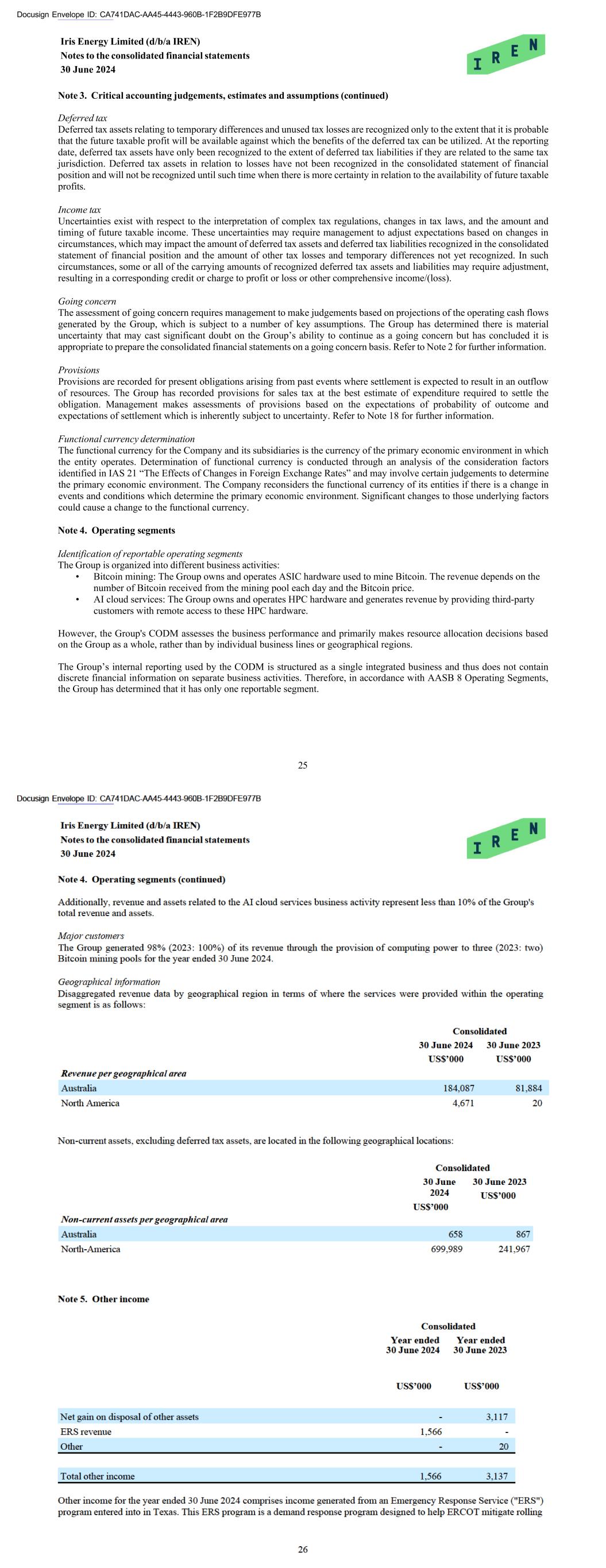
Docusign Envelope ID: CA741DAC-AA45-4443-960B-1F2B9DFE977B Iris Energy Limited (d/b/a IREN) Notes to the consolidated financial statements 30 June 2024 25 Note 3. Critical accounting judgements, estimates and assumptions (continued) Deferred tax Deferred tax assets relating to temporary differences and unused tax losses are recognized only to the extent that it is probable that the future taxable profit will be available against which the benefits of the deferred tax can be utilized. At the reporting date, deferred tax assets have only been recognized to the extent of deferred tax liabilities if they are related to the same tax jurisdiction. Deferred tax assets in relation to losses have not been recognized in the consolidated statement of financial position and will not be recognized until such time when there is more certainty in relation to the availability of future taxable profits. Income tax Uncertainties exist with respect to the interpretation of complex tax regulations, changes in tax laws, and the amount and timing of future taxable income. These uncertainties may require management to adjust expectations based on changes in circumstances, which may impact the amount of deferred tax assets and deferred tax liabilities recognized in the consolidated statement of financial position and the amount of other tax losses and temporary differences not yet recognized. In such circumstances, some or all of the carrying amounts of recognized deferred tax assets and liabilities may require adjustment, resulting in a corresponding credit or charge to profit or loss or other comprehensive income/(loss). Going concern The assessment of going concern requires management to make judgements based on projections of the operating cash flows generated by the Group, which is subject to a number of key assumptions. The Group has determined there is material uncertainty that may cast significant doubt on the Group’s ability to continue as a going concern but has concluded it is appropriate to prepare the consolidated financial statements on a going concern basis. Refer to Note 2 for further information. Provisions Provisions are recorded for present obligations arising from past events where settlement is expected to result in an outflow of resources. The Group has recorded provisions for sales tax at the best estimate of expenditure required to settle the obligation. Management makes assessments of provisions based on the expectations of probability of outcome and expectations of settlement which is inherently subject to uncertainty. Refer to Note 18 for further information. Functional currency determination The functional currency for the Company and its subsidiaries is the currency of the primary economic environment in which the entity operates. Determination of functional currency is conducted through an analysis of the consideration factors identified in IAS 21 “The Effects of Changes in Foreign Exchange Rates” and may involve certain judgements to determine the primary economic environment. The Company reconsiders the functional currency of its entities if there is a change in events and conditions which determine the primary economic environment. Significant changes to those underlying factors could cause a change to the functional currency. Note 4. Operating segments Identification of reportable operating segments The Group is organized into different business activities: • Bitcoin mining: The Group owns and operates ASIC hardware used to mine Bitcoin. The revenue depends on the number of Bitcoin received from the mining pool each day and the Bitcoin price. • AI cloud services: The Group owns and operates HPC hardware and generates revenue by providing third-party customers with remote access to these HPC hardware. However, the Group's CODM assesses the business performance and primarily makes resource allocation decisions based on the Group as a whole, rather than by individual business lines or geographical regions. The Group’s internal reporting used by the CODM is structured as a single integrated business and thus does not contain discrete financial information on separate business activities. Therefore, in accordance with AASB 8 Operating Segments, the Group has determined that it has only one reportable segment.
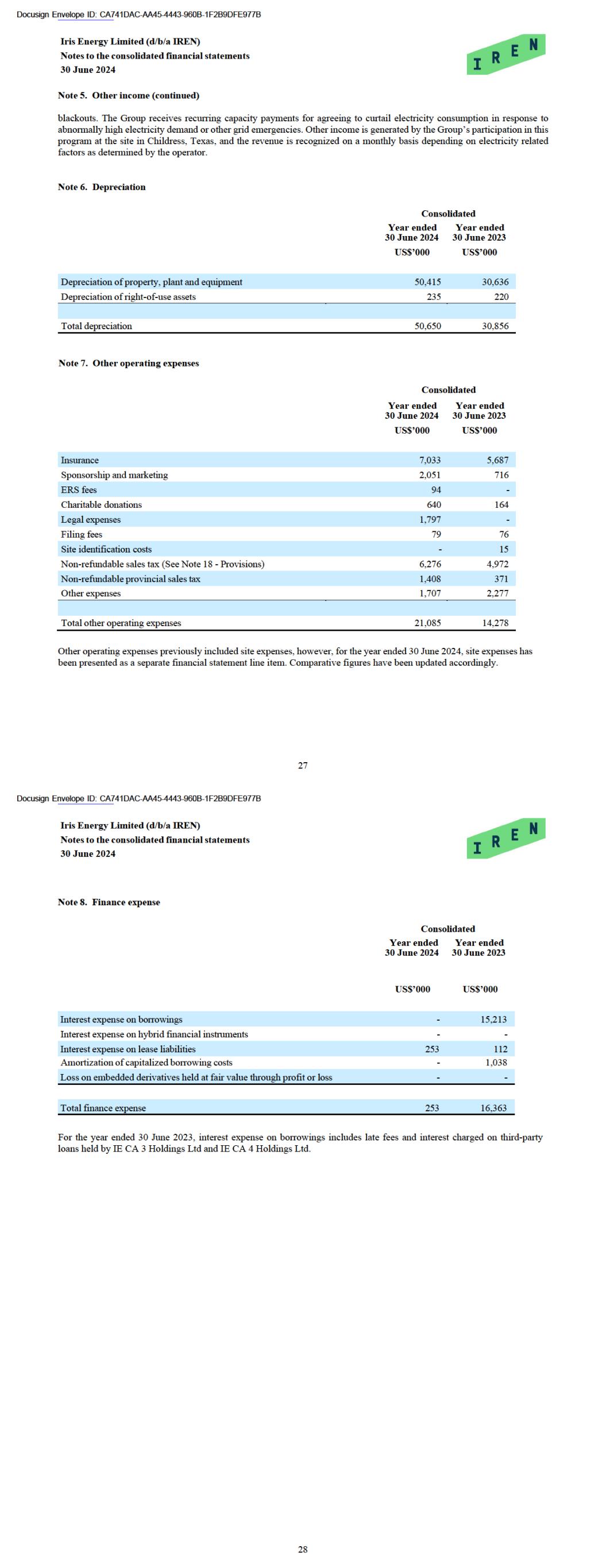
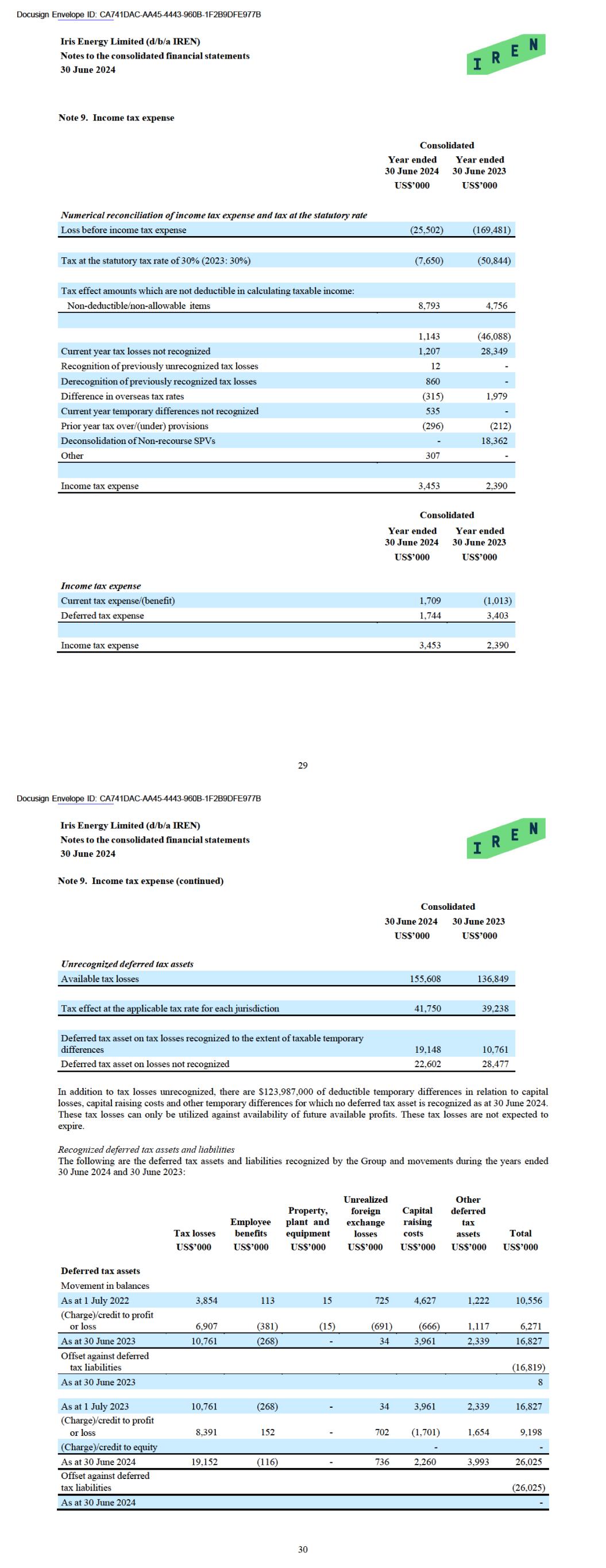
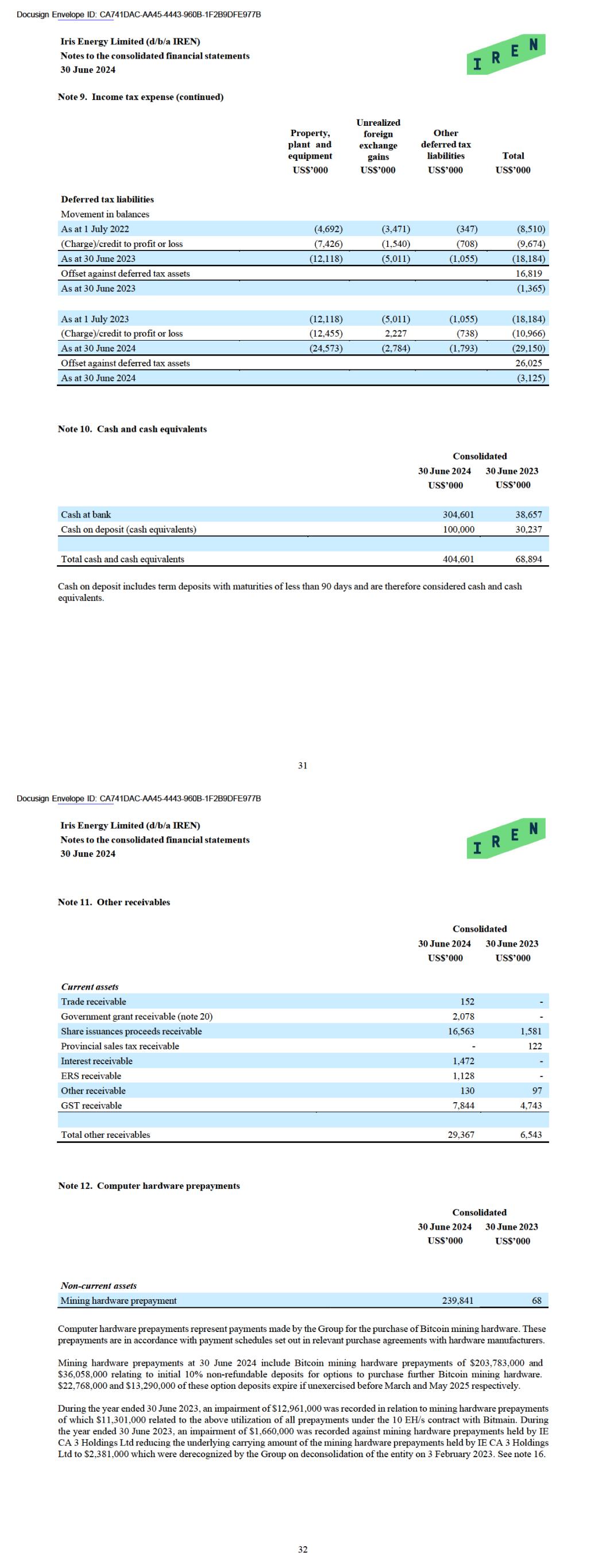
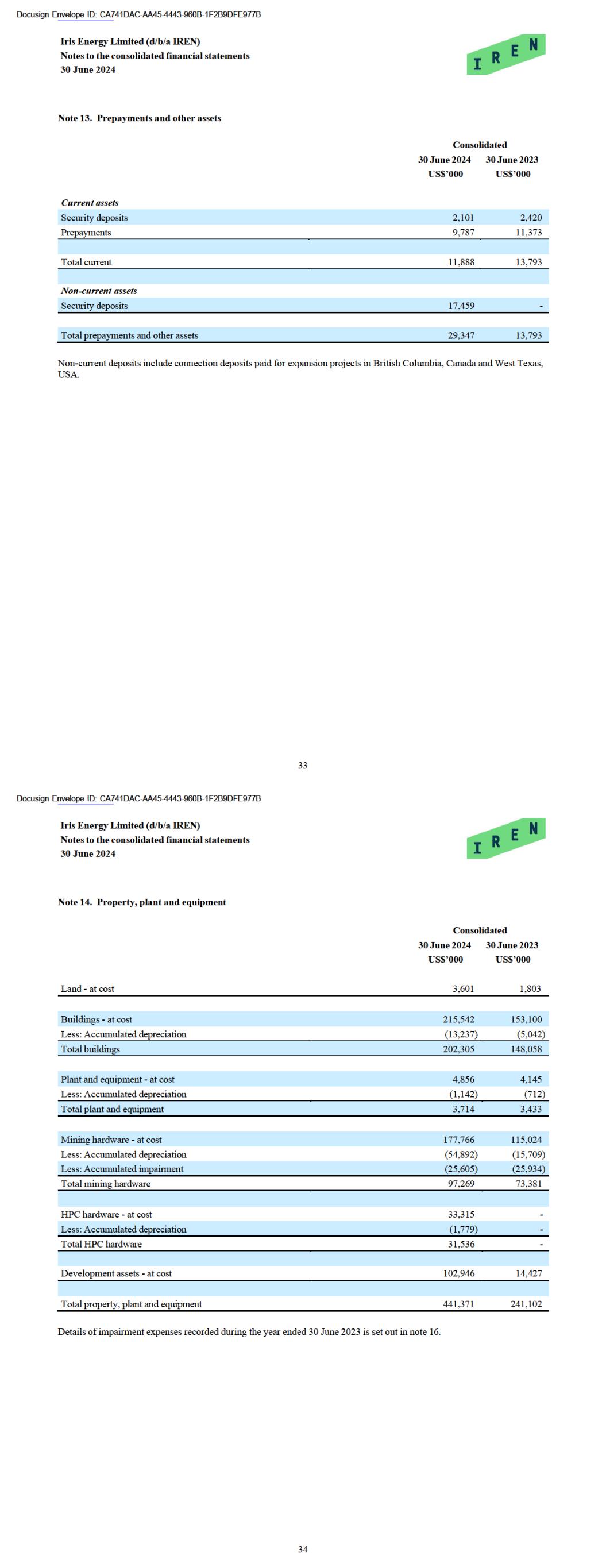
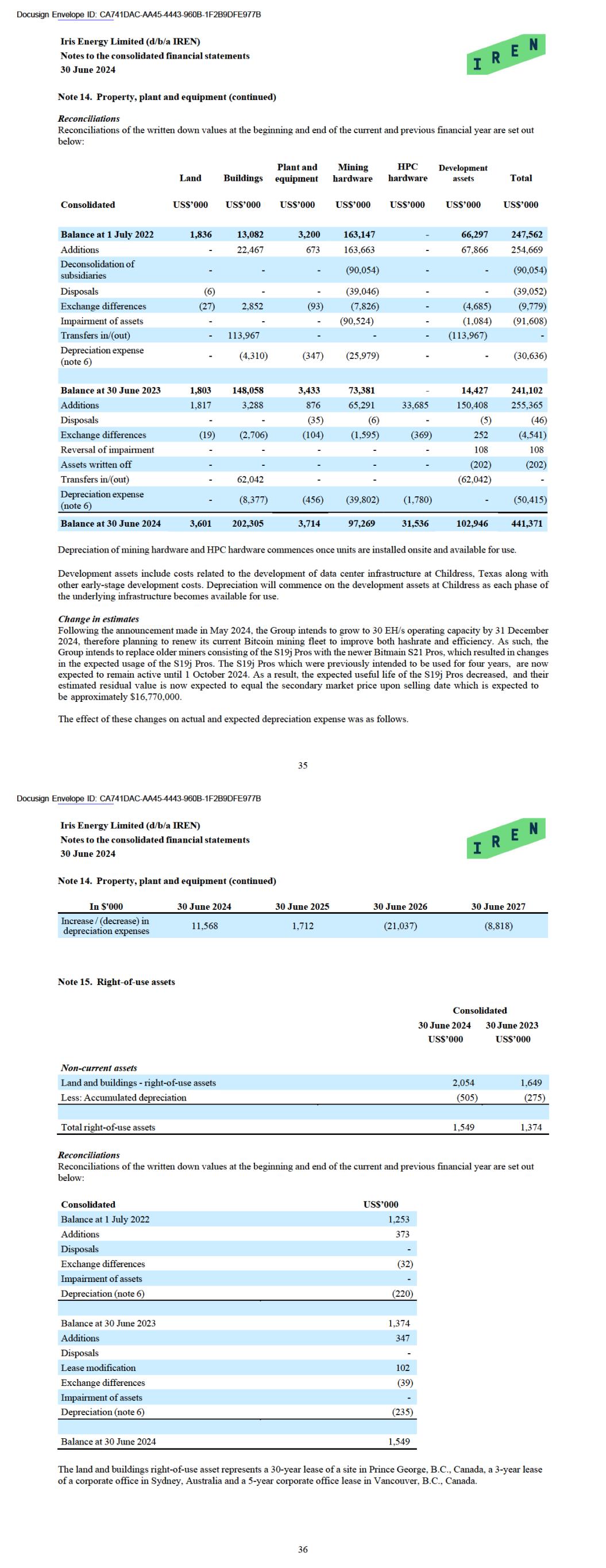
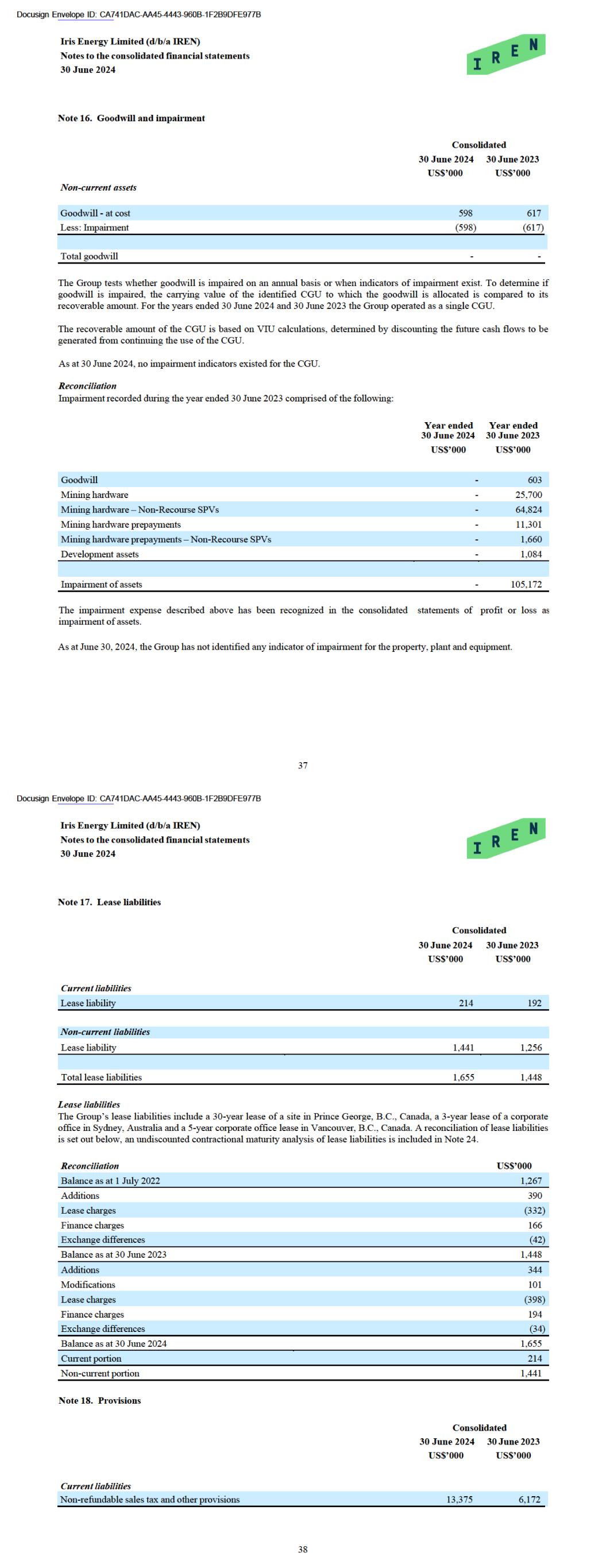
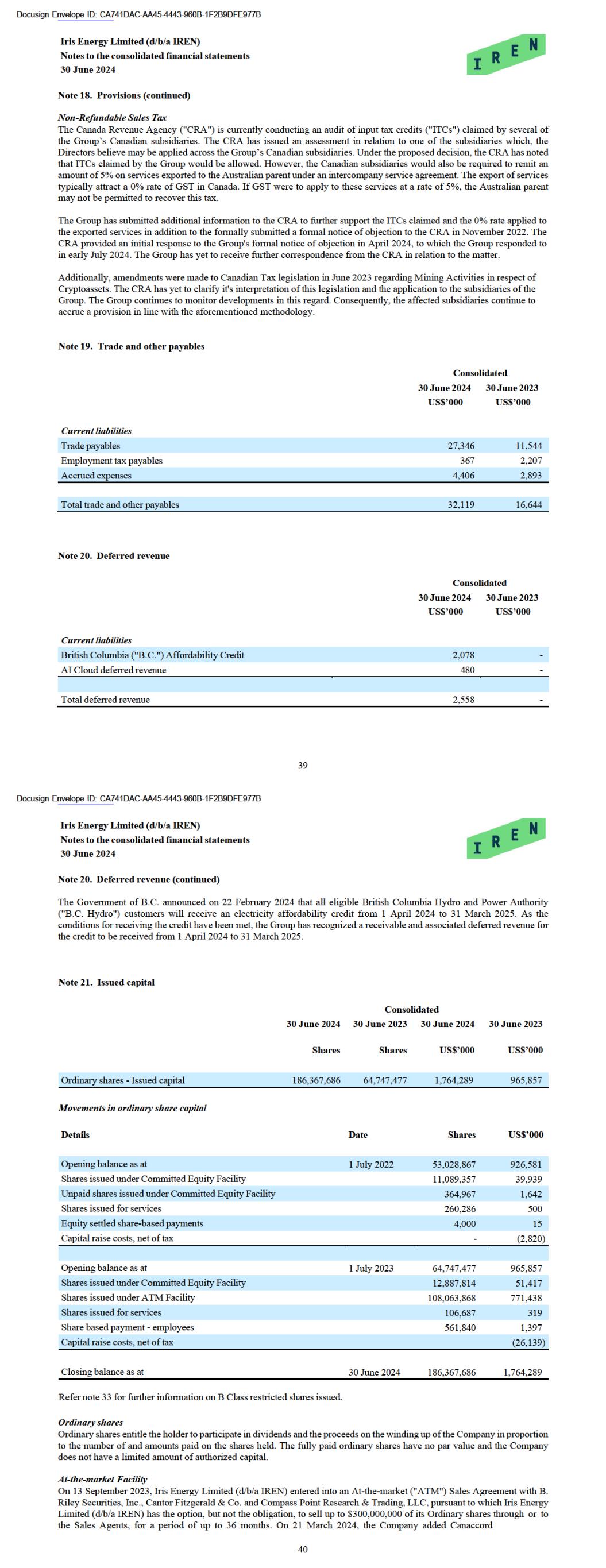
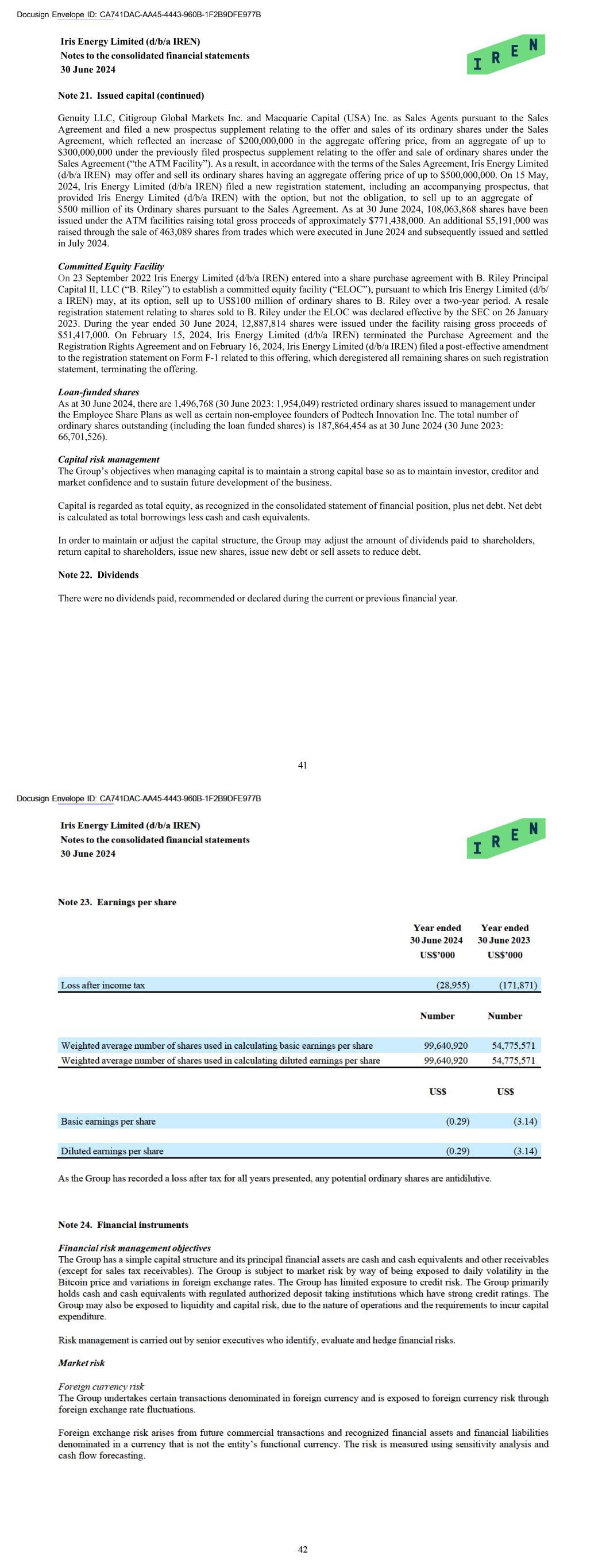
Docusign Envelope ID: CA741DAC-AA45-4443-960B-1F2B9DFE977B Iris Energy Limited (d/b/a IREN) Notes to the consolidated financial statements 30 June 2024 41 Note 21. Issued capital (continued) Genuity LLC, Citigroup Global Markets Inc. and Macquarie Capital (USA) Inc. as Sales Agents pursuant to the Sales Agreement and filed a new prospectus supplement relating to the offer and sales of its ordinary shares under the Sales Agreement, which reflected an increase of $200,000,000 in the aggregate offering price, from an aggregate of up to $300,000,000 under the previously filed prospectus supplement relating to the offer and sale of ordinary shares under the Sales Agreement (“the ATM Facility”). As a result, in accordance with the terms of the Sales Agreement, Iris Energy Limited (d/b/a IREN) may offer and sell its ordinary shares having an aggregate offering price of up to $500,000,000. On 15 May, 2024, Iris Energy Limited (d/b/a IREN) filed a new registration statement, including an accompanying prospectus, that provided Iris Energy Limited (d/b/a IREN) with the option, but not the obligation, to sell up to an aggregate of $500 million of its Ordinary shares pursuant to the Sales Agreement. As at 30 June 2024, 108,063,868 shares have been issued under the ATM facilities raising total gross proceeds of approximately $771,438,000. An additional $5,191,000 was raised through the sale of 463,089 shares from trades which were executed in June 2024 and subsequently issued and settled in July 2024. Committed Equity Facility On 23 September 2022 Iris Energy Limited (d/b/a IREN) entered into a share purchase agreement with B. Riley Principal Capital II, LLC (“B. Riley”) to establish a committed equity facility (“ELOC”), pursuant to which Iris Energy Limited (d/b/ a IREN) may, at its option, sell up to US$100 million of ordinary shares to B. Riley over a two-year period. A resale registration statement relating to shares sold to B. Riley under the ELOC was declared effective by the SEC on 26 January 2023. During the year ended 30 June 2024, 12,887,814 shares were issued under the facility raising gross proceeds of $51,417,000. On February 15, 2024, Iris Energy Limited (d/b/a IREN) terminated the Purchase Agreement and the Registration Rights Agreement and on February 16, 2024, Iris Energy Limited (d/b/a IREN) filed a post-effective amendment to the registration statement on Form F-1 related to this offering, which deregistered all remaining shares on such registration statement, terminating the offering. Loan-funded shares As at 30 June 2024, there are 1,496,768 (30 June 2023: 1,954,049) restricted ordinary shares issued to management under the Employee Share Plans as well as certain non-employee founders of Podtech Innovation Inc. The total number of ordinary shares outstanding (including the loan funded shares) is 187,864,454 as at 30 June 2024 (30 June 2023: 66,701,526). Capital risk management The Group’s objectives when managing capital is to maintain a strong capital base so as to maintain investor, creditor and market confidence and to sustain future development of the business. Capital is regarded as total equity, as recognized in the consolidated statement of financial position, plus net debt. Net debt is calculated as total borrowings less cash and cash equivalents. In order to maintain or adjust the capital structure, the Group may adjust the amount of dividends paid to shareholders, return capital to shareholders, issue new shares, issue new debt or sell assets to reduce debt. Note 22. Dividends There were no dividends paid, recommended or declared during the current or previous financial year.
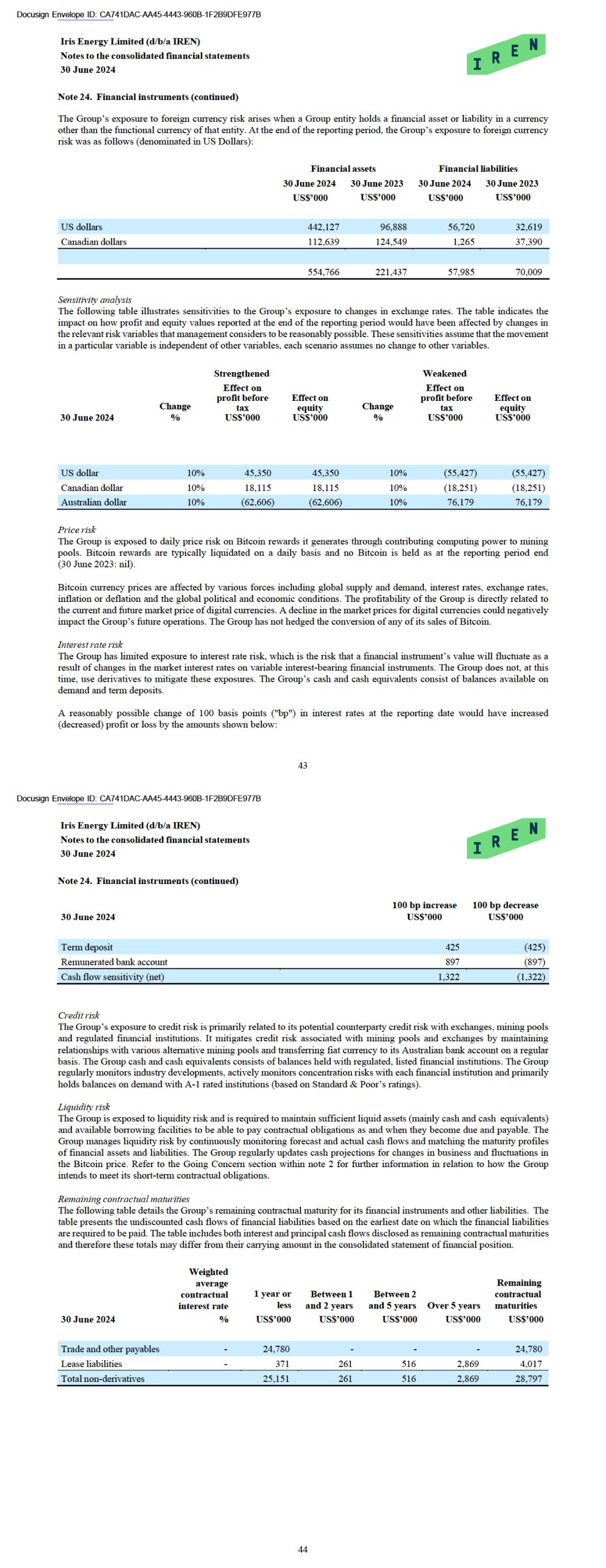
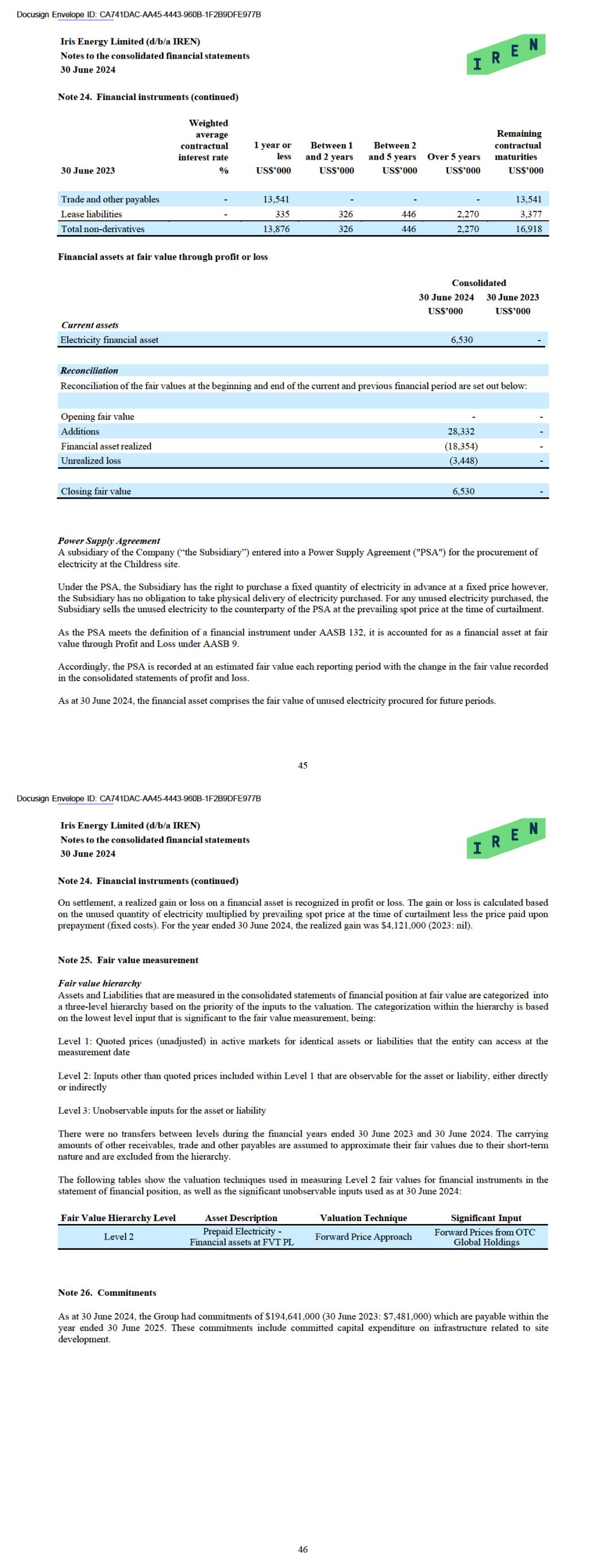
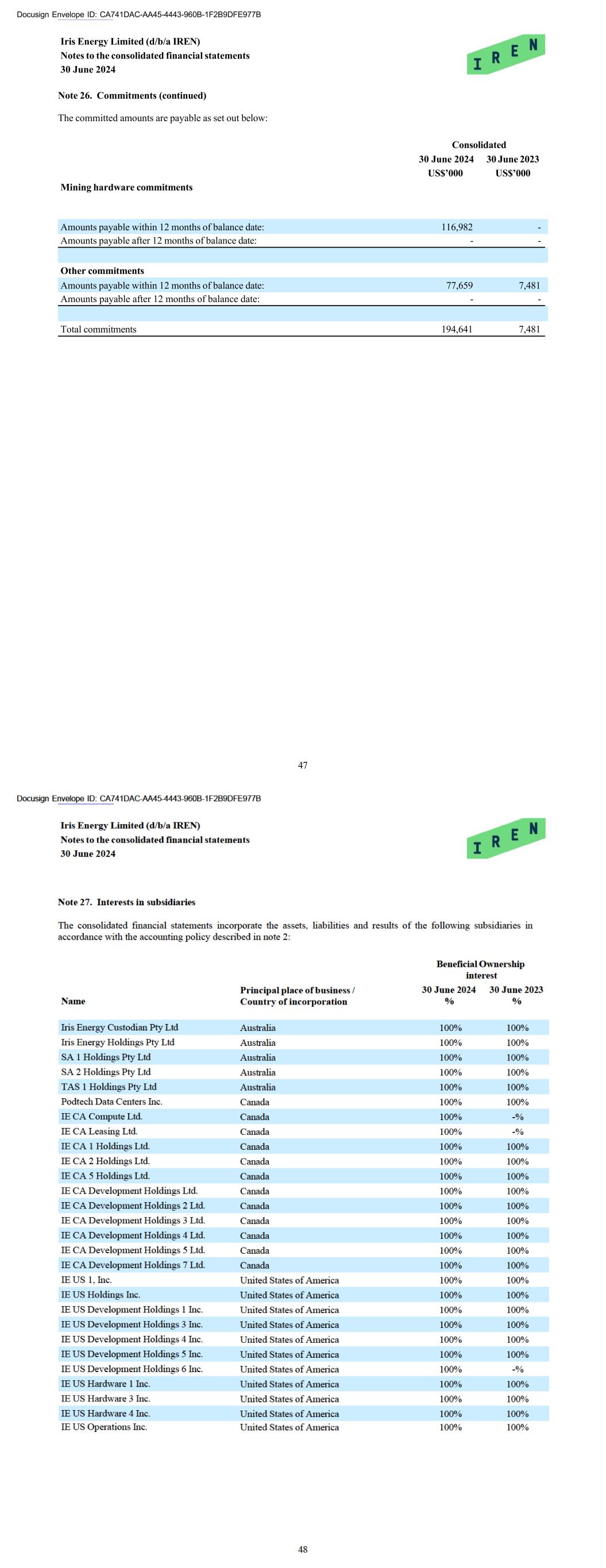
Docusign Envelope ID: CA741DAC-AA45-4443-960B-1F2B9DFE977B Iris Energy Limited (d/b/a IREN) Notes to the consolidated financial statements 30 June 2024 47 Note 26. Commitments (continued) The committed amounts are payable as set out below: Mining hardware commitments Consolidated 30 June 2024 30 June 2023 US$’000 US$’000 Amounts payable after 12 months of balance date: - - Other commitments Amounts payable after 12 months of balance date: - - Total commitments 194,641 7,481 Amounts payable within 12 months of balance date: 116,982 - Amounts payable within 12 months of balance date: 77,659 7,481
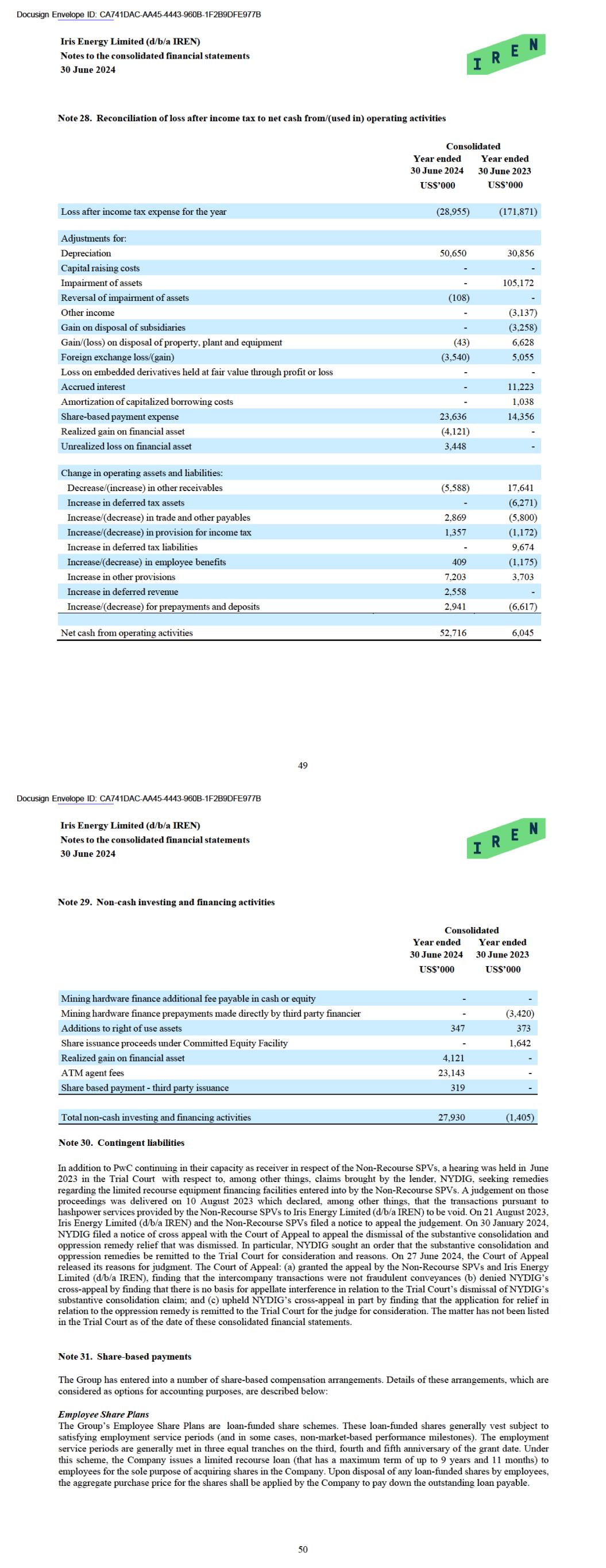
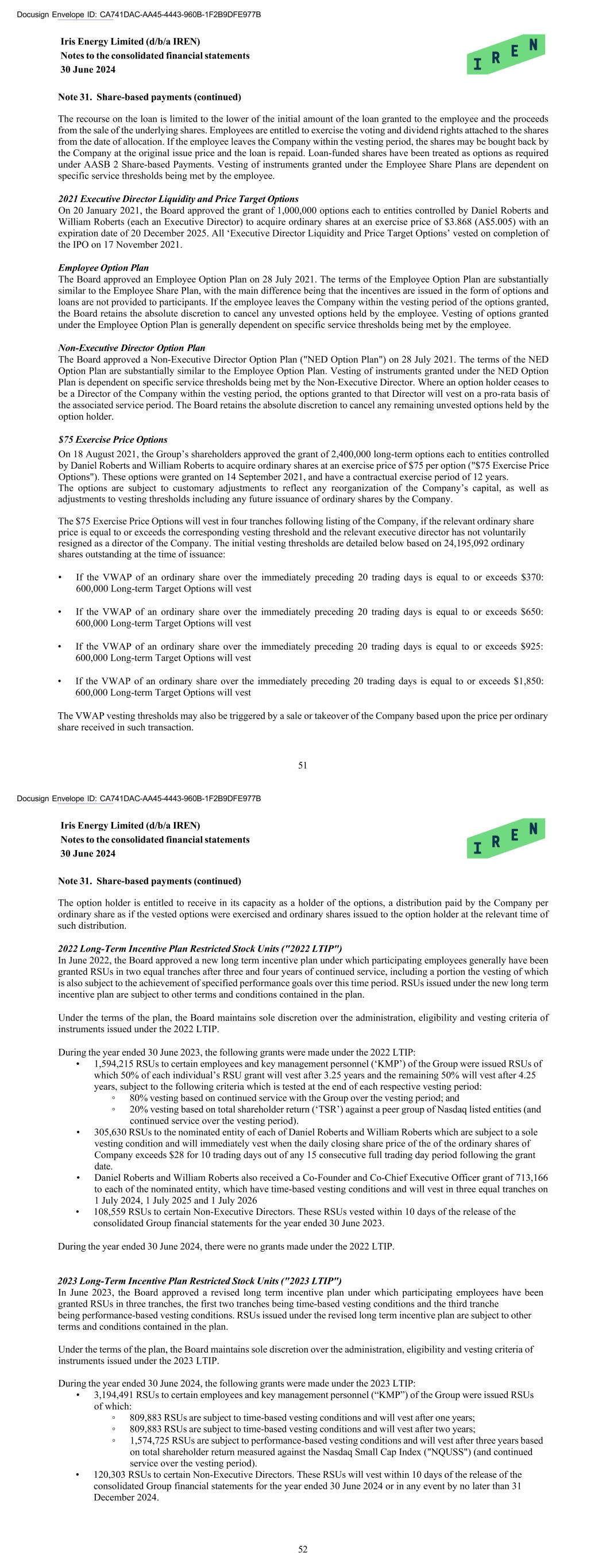
Docusign Envelope ID: CA741DAC-AA45-4443-960B-1F2B9DFE977B Iris Energy Limited (d/b/a IREN) Notes to the consolidated financial statements 30 June 2024 Note 31. Share-based payments (continued) 51 The recourse on the loan is limited to the lower of the initial amount of the loan granted to the employee and the proceeds from the sale of the underlying shares. Employees are entitled to exercise the voting and dividend rights attached to the shares from the date of allocation. If the employee leaves the Company within the vesting period, the shares may be bought back by the Company at the original issue price and the loan is repaid. Loan-funded shares have been treated as options as required under AASB 2 Share-based Payments. Vesting of instruments granted under the Employee Share Plans are dependent on specific service thresholds being met by the employee. 2021 Executive Director Liquidity and Price Target Options On 20 January 2021, the Board approved the grant of 1,000,000 options each to entities controlled by Daniel Roberts and William Roberts (each an Executive Director) to acquire ordinary shares at an exercise price of $3.868 (A$5.005) with an expiration date of 20 December 2025. All ‘Executive Director Liquidity and Price Target Options’ vested on completion of the IPO on 17 November 2021. Employee Option Plan The Board approved an Employee Option Plan on 28 July 2021. The terms of the Employee Option Plan are substantially similar to the Employee Share Plan, with the main difference being that the incentives are issued in the form of options and loans are not provided to participants. If the employee leaves the Company within the vesting period of the options granted, the Board retains the absolute discretion to cancel any unvested options held by the employee. Vesting of options granted under the Employee Option Plan is generally dependent on specific service thresholds being met by the employee. Non-Executive Director Option Plan The Board approved a Non-Executive Director Option Plan ("NED Option Plan") on 28 July 2021. The terms of the NED Option Plan are substantially similar to the Employee Option Plan. Vesting of instruments granted under the NED Option Plan is dependent on specific service thresholds being met by the Non-Executive Director. Where an option holder ceases to be a Director of the Company within the vesting period, the options granted to that Director will vest on a pro-rata basis of the associated service period. The Board retains the absolute discretion to cancel any remaining unvested options held by the option holder. $75 Exercise Price Options On 18 August 2021, the Group’s shareholders approved the grant of 2,400,000 long-term options each to entities controlled by Daniel Roberts and William Roberts to acquire ordinary shares at an exercise price of $75 per option ("$75 Exercise Price Options"). These options were granted on 14 September 2021, and have a contractual exercise period of 12 years. The options are subject to customary adjustments to reflect any reorganization of the Company’s capital, as well as adjustments to vesting thresholds including any future issuance of ordinary shares by the Company. The $75 Exercise Price Options will vest in four tranches following listing of the Company, if the relevant ordinary share price is equal to or exceeds the corresponding vesting threshold and the relevant executive director has not voluntarily resigned as a director of the Company. The initial vesting thresholds are detailed below based on 24,195,092 ordinary shares outstanding at the time of issuance: • If the VWAP of an ordinary share over the immediately preceding 20 trading days is equal to or exceeds $370: 600,000 Long-term Target Options will vest • If the VWAP of an ordinary share over the immediately preceding 20 trading days is equal to or exceeds $650: 600,000 Long-term Target Options will vest • If the VWAP of an ordinary share over the immediately preceding 20 trading days is equal to or exceeds $925: 600,000 Long-term Target Options will vest • If the VWAP of an ordinary share over the immediately preceding 20 trading days is equal to or exceeds $1,850: 600,000 Long-term Target Options will vest The VWAP vesting thresholds may also be triggered by a sale or takeover of the Company based upon the price per ordinary share received in such transaction. Docusign Envelope ID: CA741DAC-AA45-4443-960B-1F2B9DFE977B Iris Energy Limited (d/b/a IREN) Notes to the consolidated financial statements 30 June 2024 Note 31. Share-based payments (continued) 52 The option holder is entitled to receive in its capacity as a holder of the options, a distribution paid by the Company per ordinary share as if the vested options were exercised and ordinary shares issued to the option holder at the relevant time of such distribution. 2022 Long-Term Incentive Plan Restricted Stock Units ("2022 LTIP") In June 2022, the Board approved a new long term incentive plan under which participating employees generally have been granted RSUs in two equal tranches after three and four years of continued service, including a portion the vesting of which is also subject to the achievement of specified performance goals over this time period. RSUs issued under the new long term incentive plan are subject to other terms and conditions contained in the plan. Under the terms of the plan, the Board maintains sole discretion over the administration, eligibility and vesting criteria of instruments issued under the 2022 LTIP. During the year ended 30 June 2023, the following grants were made under the 2022 LTIP: • 1,594,215 RSUs to certain employees and key management personnel (‘KMP’) of the Group were issued RSUs of which 50% of each individual’s RSU grant will vest after 3.25 years and the remaining 50% will vest after 4.25 years, subject to the following criteria which is tested at the end of each respective vesting period: ◦ 80% vesting based on continued service with the Group over the vesting period; and ◦ 20% vesting based on total shareholder return (‘TSR’) against a peer group of Nasdaq listed entities (and continued service over the vesting period). • 305,630 RSUs to the nominated entity of each of Daniel Roberts and William Roberts which are subject to a sole vesting condition and will immediately vest when the daily closing share price of the of the ordinary shares of Company exceeds $28 for 10 trading days out of any 15 consecutive full trading day period following the grant date. • Daniel Roberts and William Roberts also received a Co-Founder and Co-Chief Executive Officer grant of 713,166 to each of the nominated entity, which have time-based vesting conditions and will vest in three equal tranches on 1 July 2024, 1 July 2025 and 1 July 2026 • 108,559 RSUs to certain Non-Executive Directors. These RSUs vested within 10 days of the release of the consolidated Group financial statements for the year ended 30 June 2023. During the year ended 30 June 2024, there were no grants made under the 2022 LTIP. 2023 Long-Term Incentive Plan Restricted Stock Units ("2023 LTIP") In June 2023, the Board approved a revised long term incentive plan under which participating employees have been granted RSUs in three tranches, the first two tranches being time-based vesting conditions and the third tranche being performance-based vesting conditions. RSUs issued under the revised long term incentive plan are subject to other terms and conditions contained in the plan. Under the terms of the plan, the Board maintains sole discretion over the administration, eligibility and vesting criteria of instruments issued under the 2023 LTIP. During the year ended 30 June 2024, the following grants were made under the 2023 LTIP: • 3,194,491 RSUs to certain employees and key management personnel (“KMP”) of the Group were issued RSUs of which: ◦ 809,883 RSUs are subject to time-based vesting conditions and will vest after one years; ◦ 809,883 RSUs are subject to time-based vesting conditions and will vest after two years; ◦ 1,574,725 RSUs are subject to performance-based vesting conditions and will vest after three years based on total shareholder return measured against the Nasdaq Small Cap Index ("NQUSS") (and continued service over the vesting period). • 120,303 RSUs to certain Non-Executive Directors. These RSUs will vest within 10 days of the release of the consolidated Group financial statements for the year ended 30 June 2024 or in any event by no later than 31 December 2024.
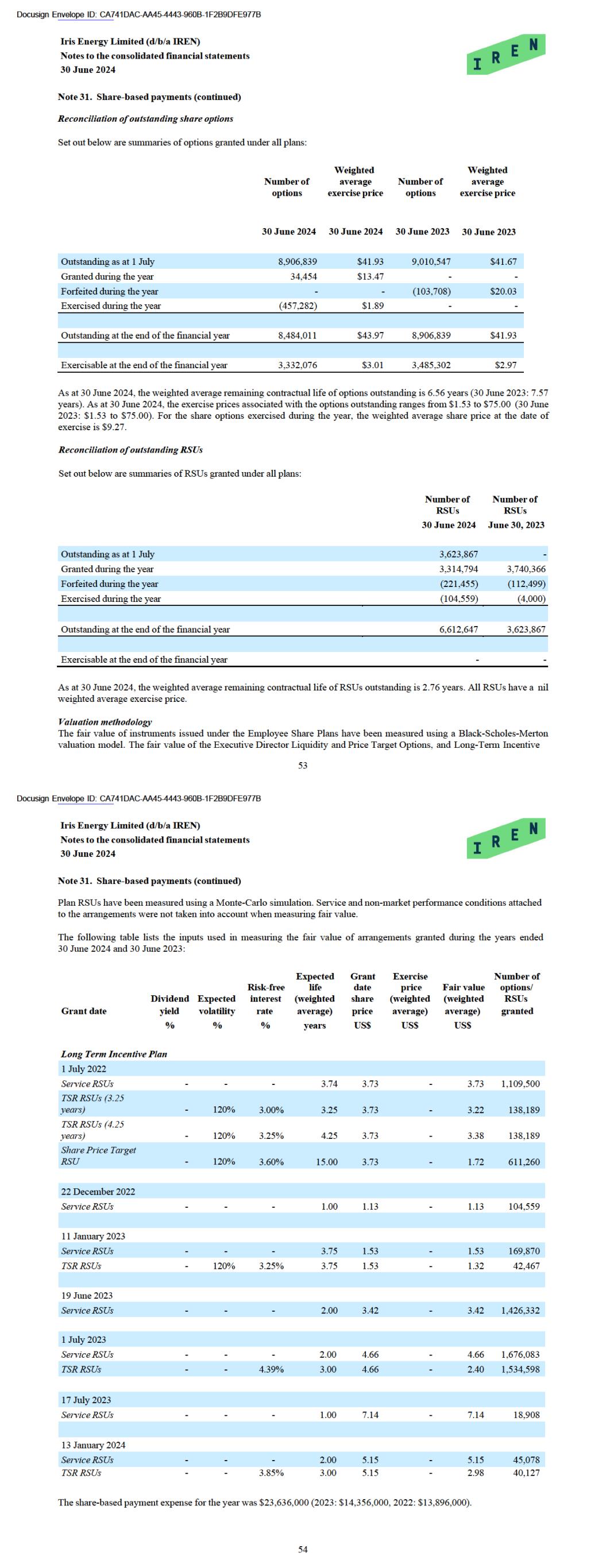
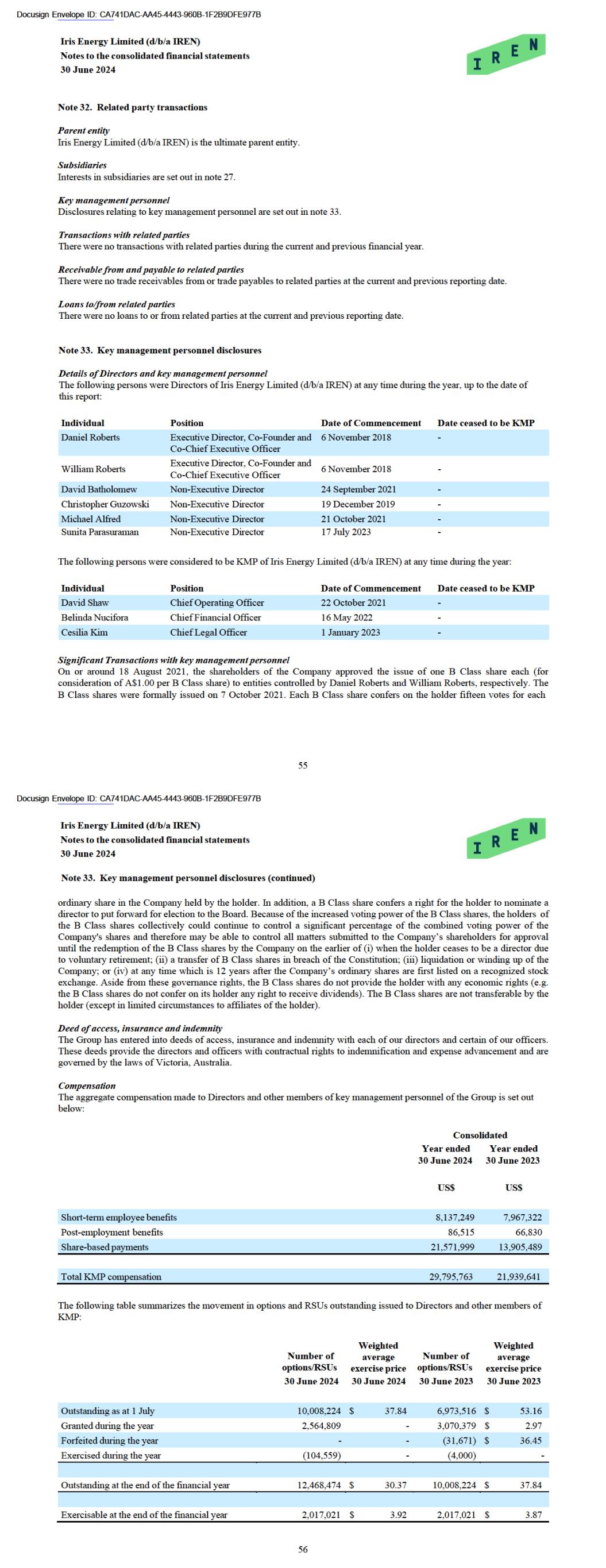
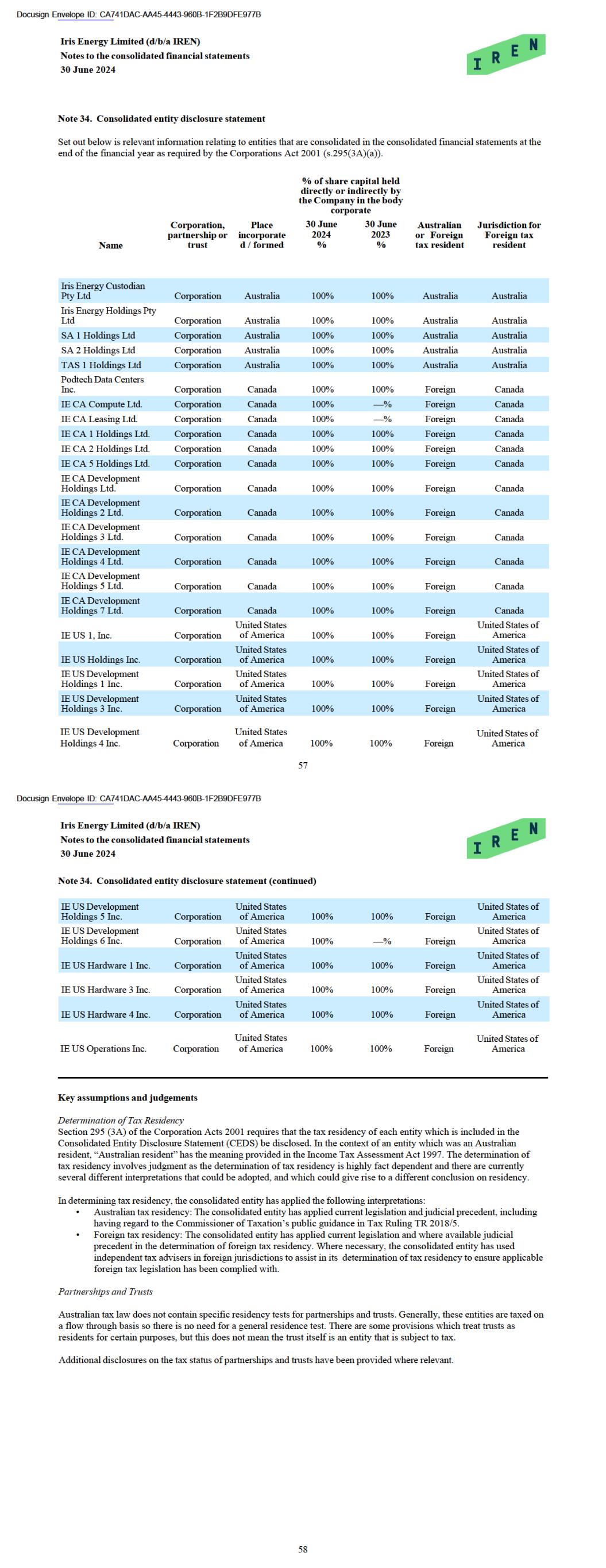
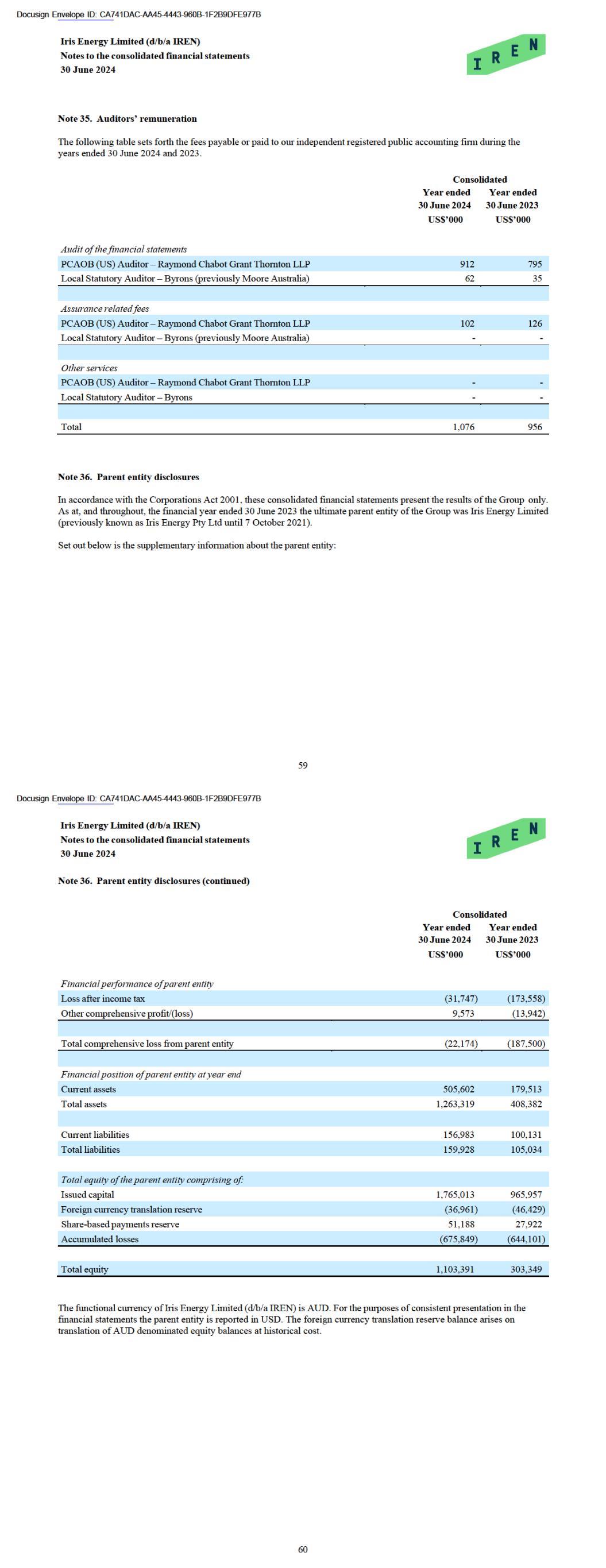
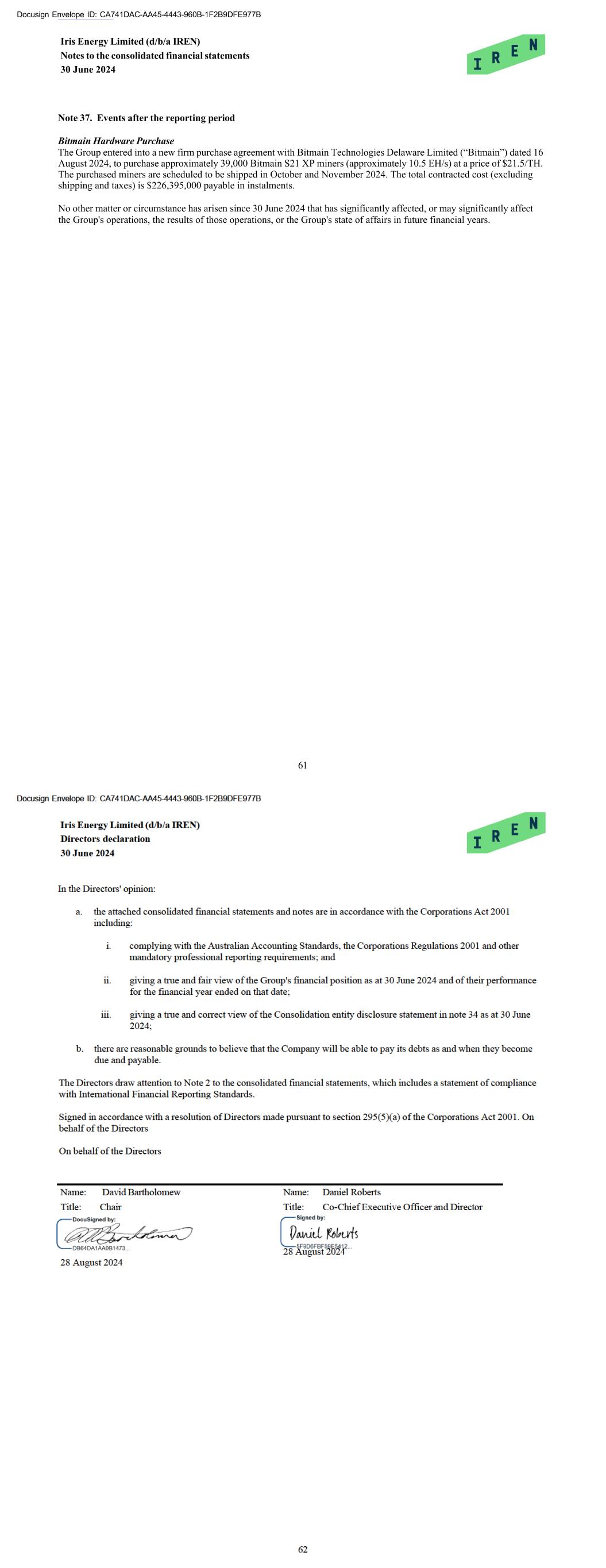
Docusign Envelope ID: CA741DAC-AA45-4443-960B-1F2B9DFE977B Iris Energy Limited (d/b/a IREN) Notes to the consolidated financial statements 30 June 2024 61 Note 37. Events after the reporting period Bitmain Hardware Purchase The Group entered into a new firm purchase agreement with Bitmain Technologies Delaware Limited (“Bitmain”) dated 16 August 2024, to purchase approximately 39,000 Bitmain S21 XP miners (approximately 10.5 EH/s) at a price of $21.5/TH. The purchased miners are scheduled to be shipped in October and November 2024. The total contracted cost (excluding shipping and taxes) is $226,395,000 payable in instalments. No other matter or circumstance has arisen since 30 June 2024 that has significantly affected, or may significantly affect the Group's operations, the results of those operations, or the Group's state of affairs in future financial years.